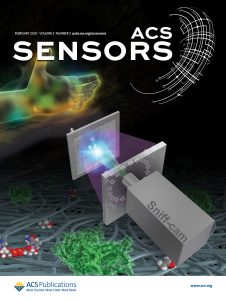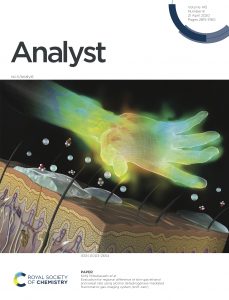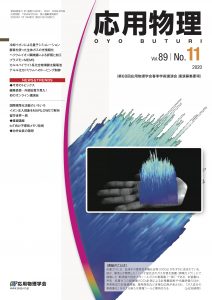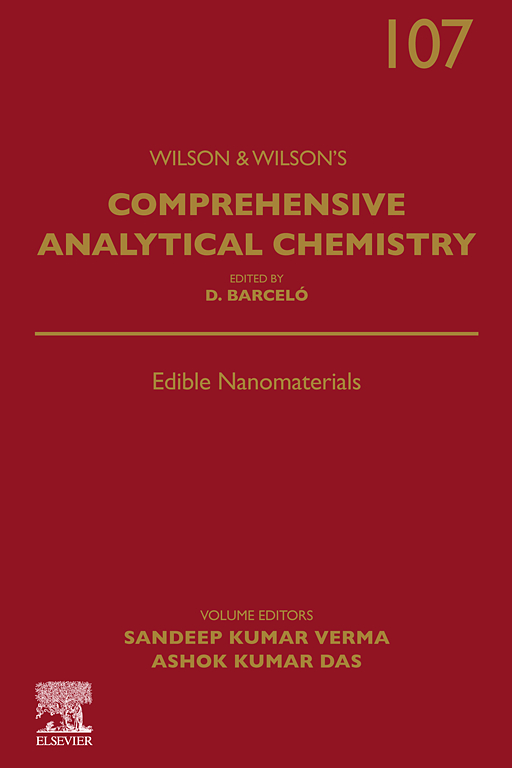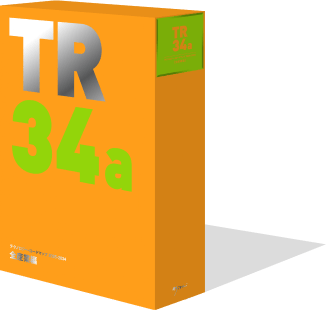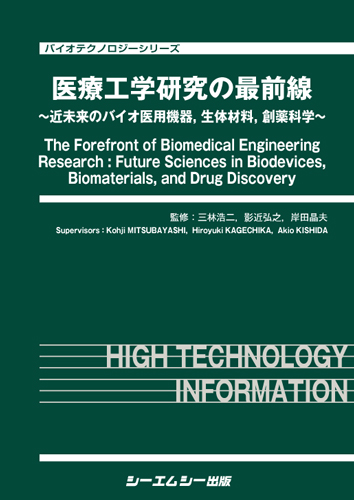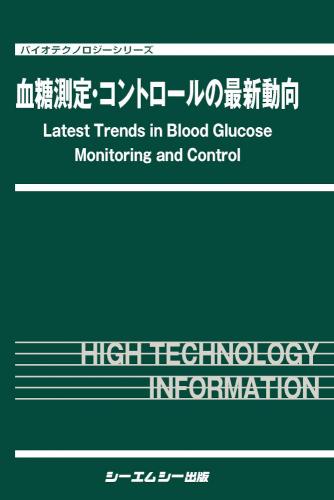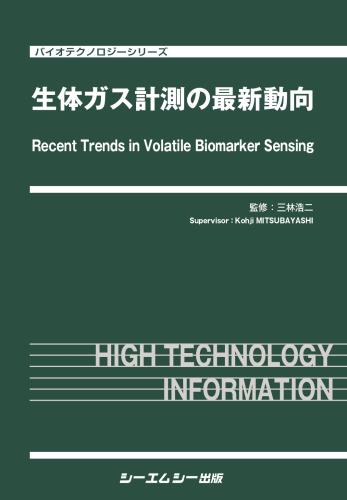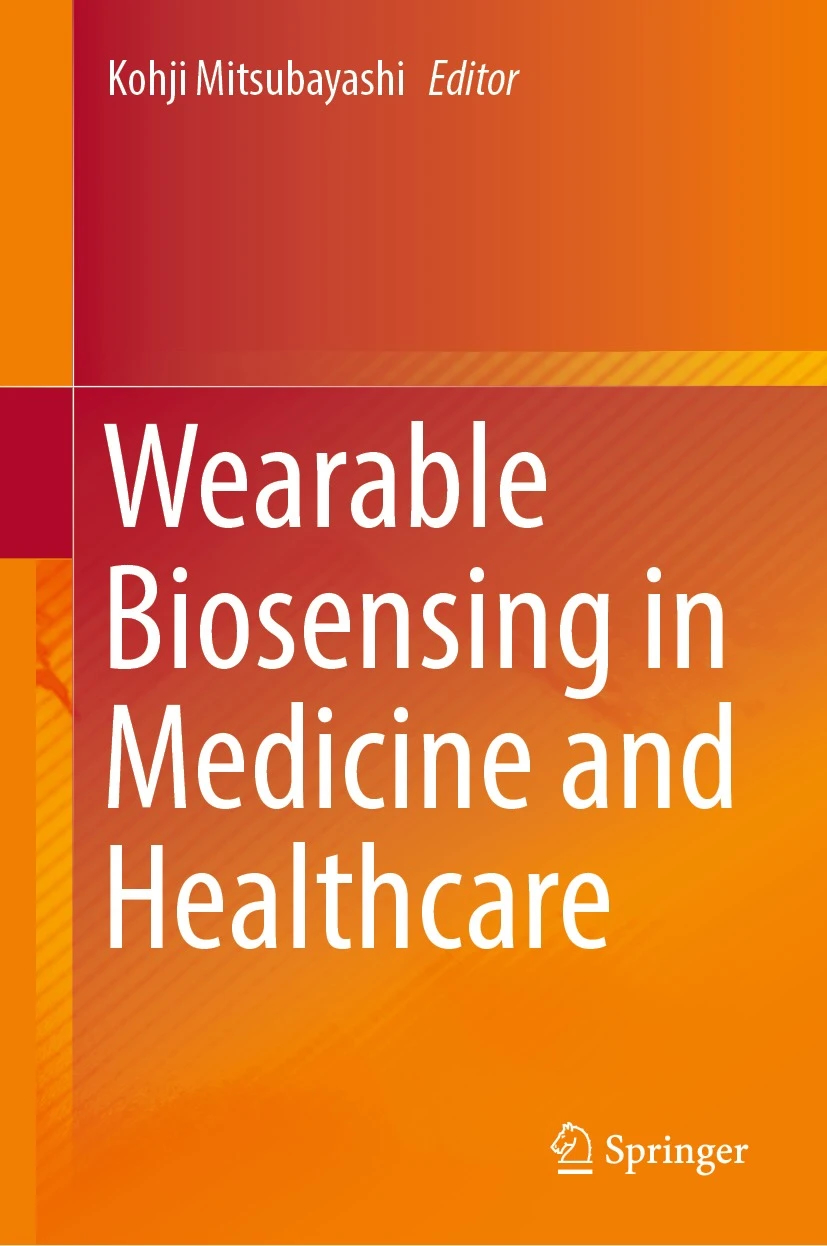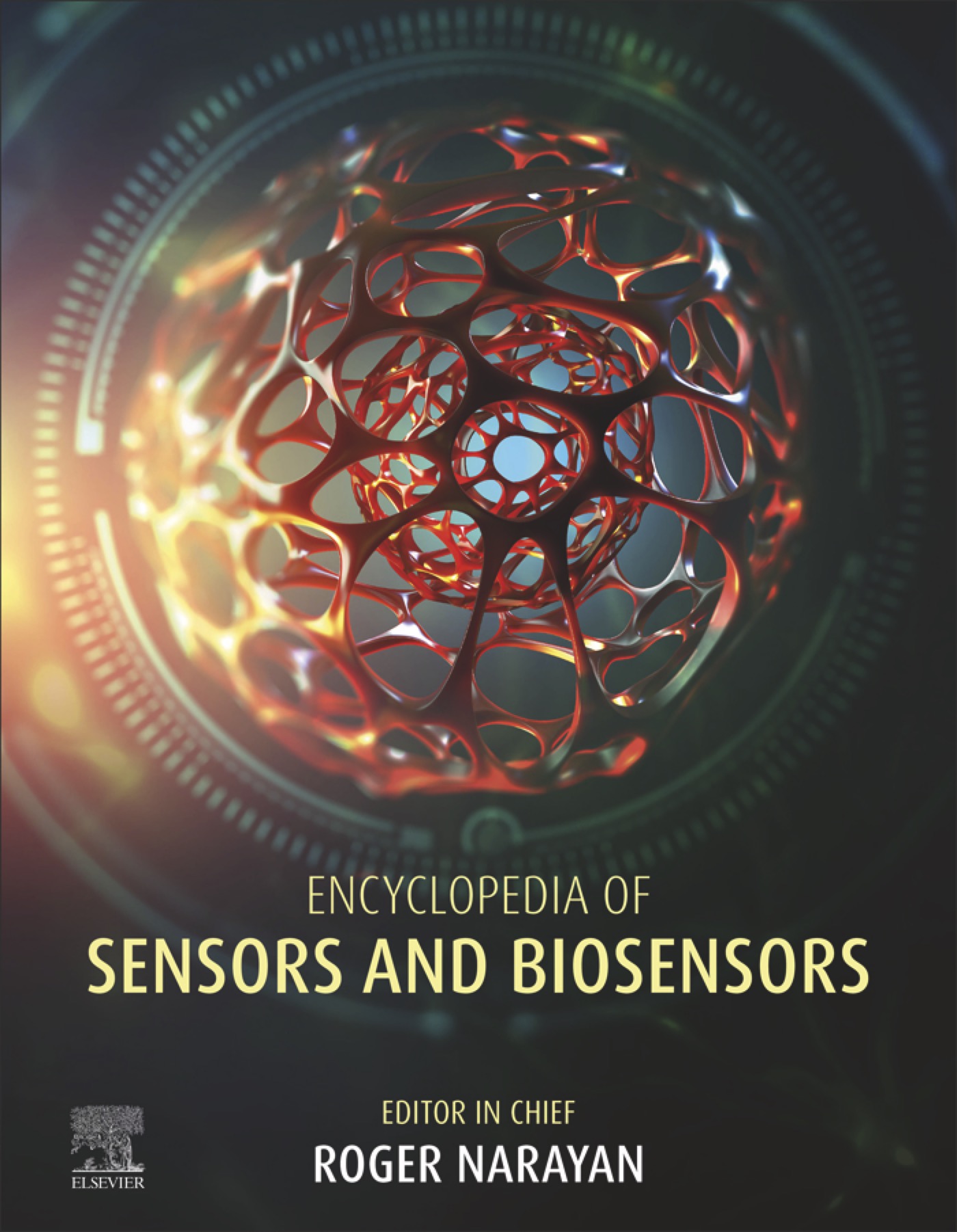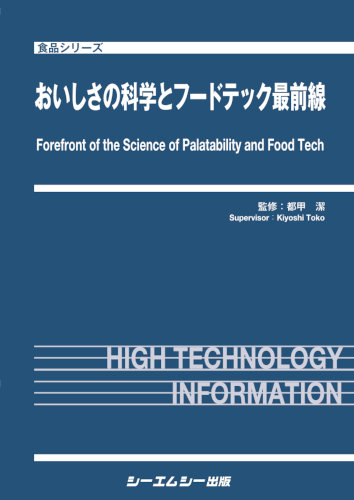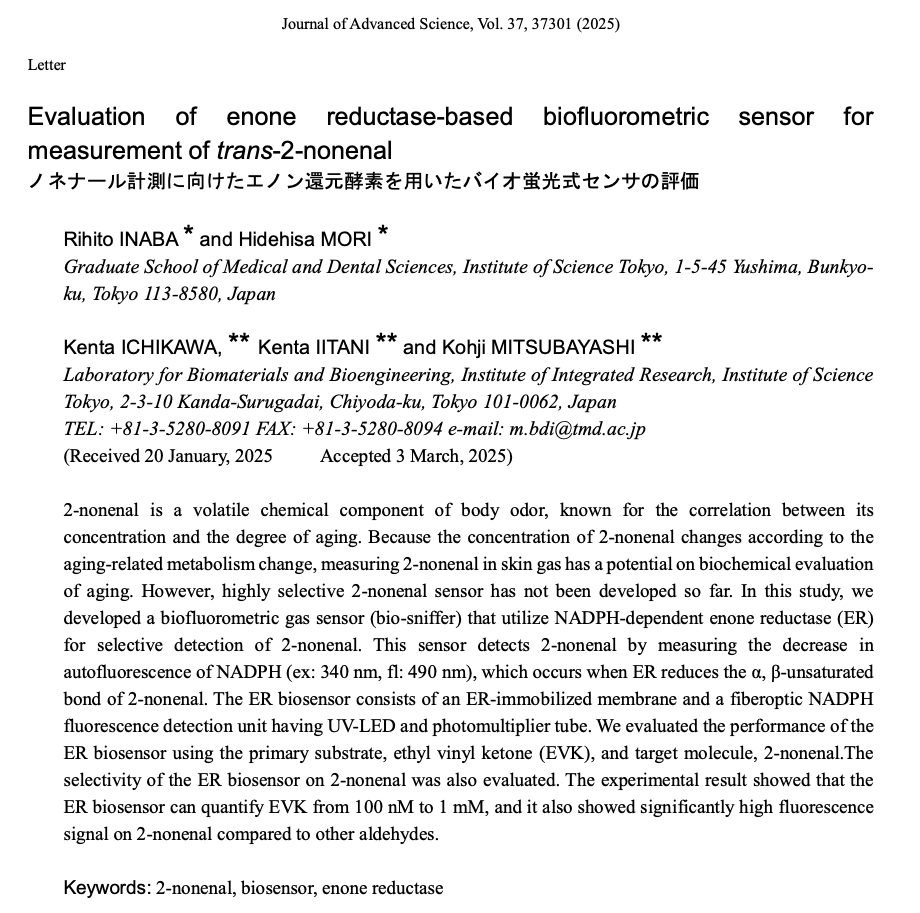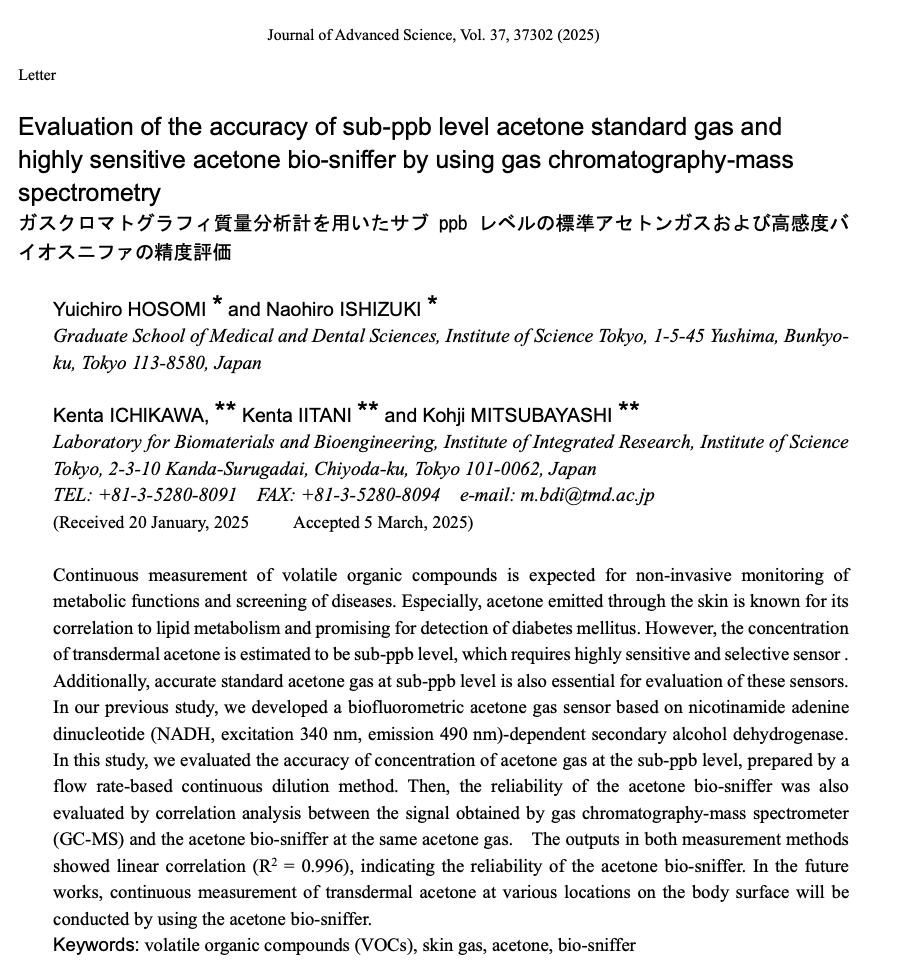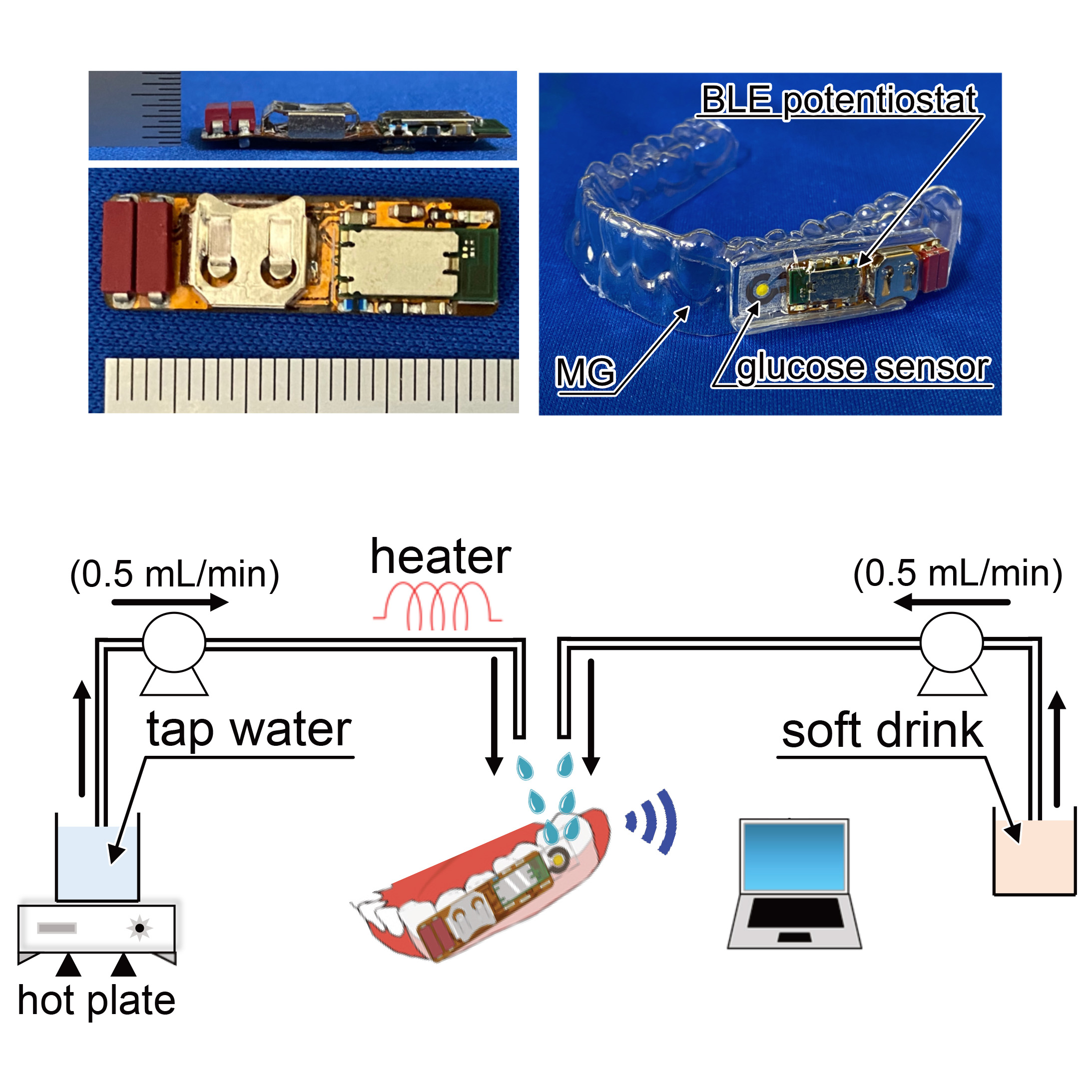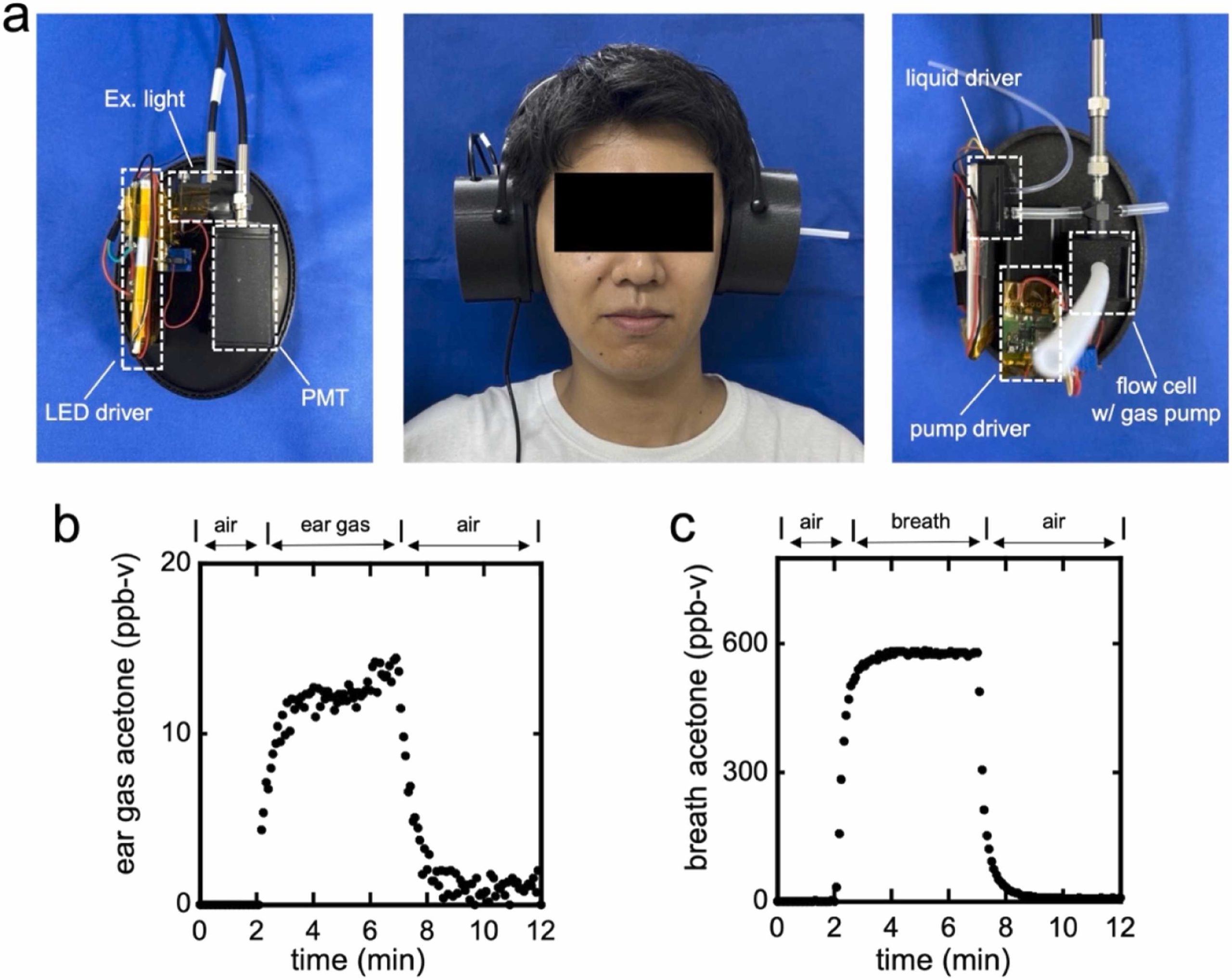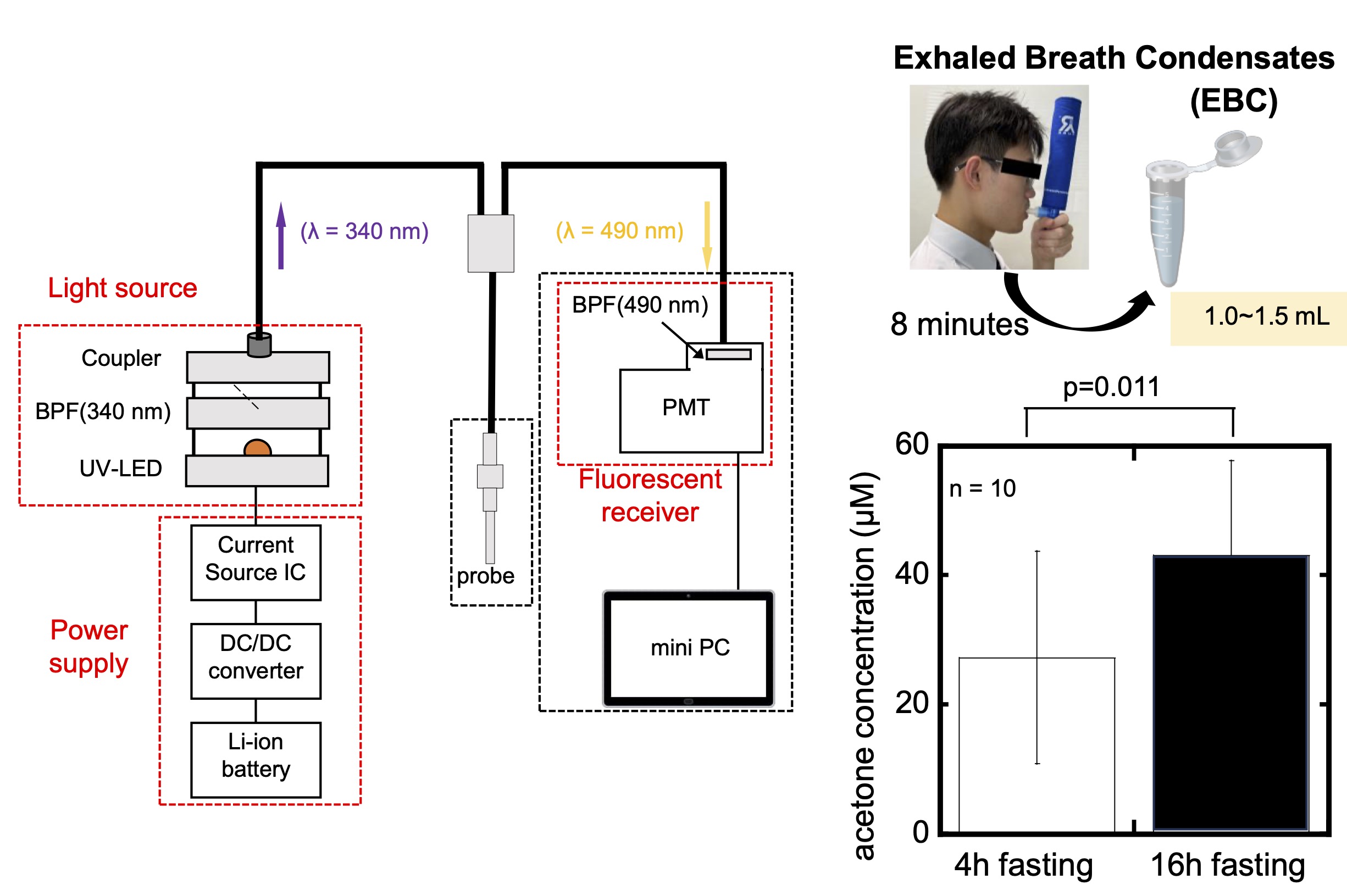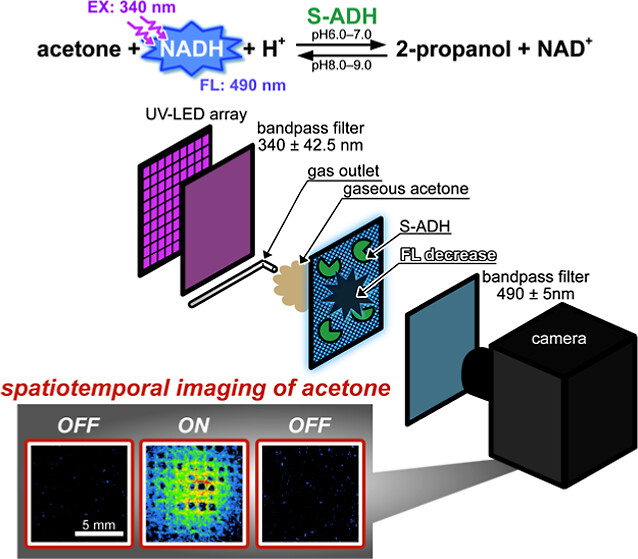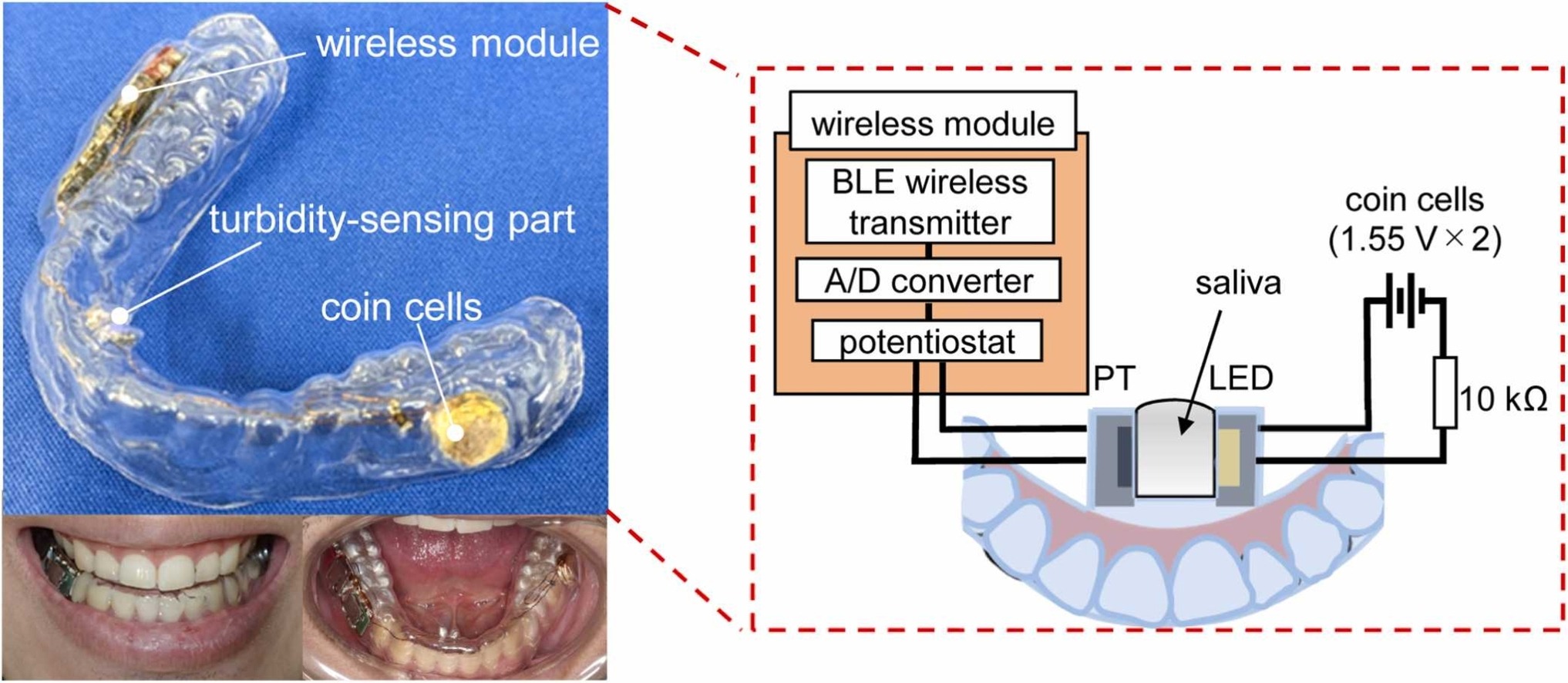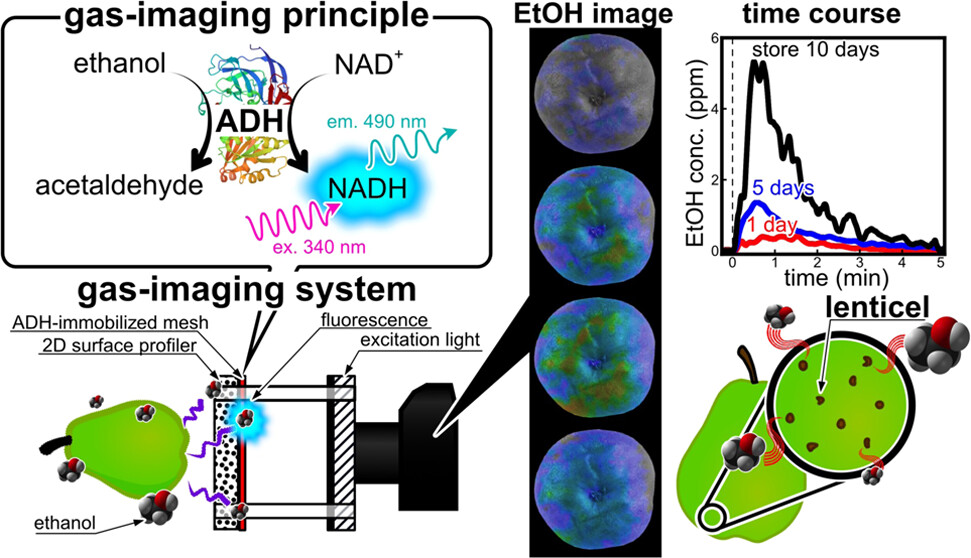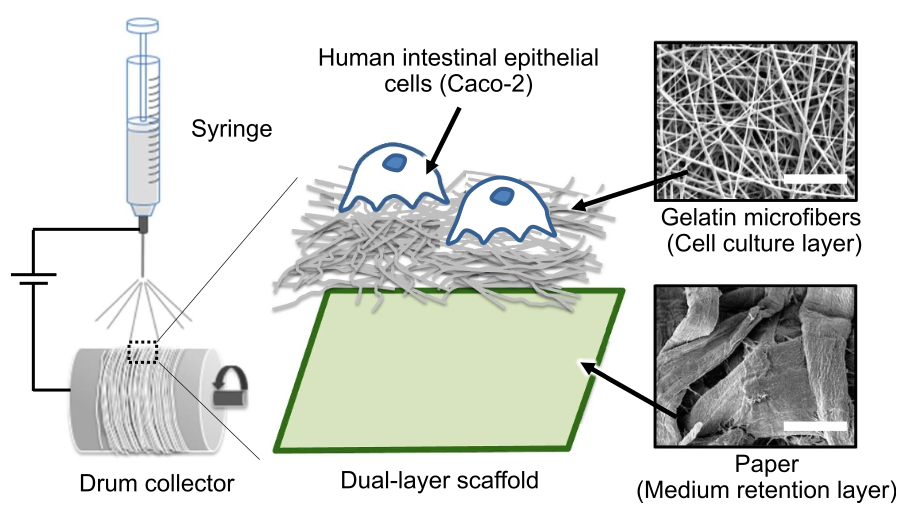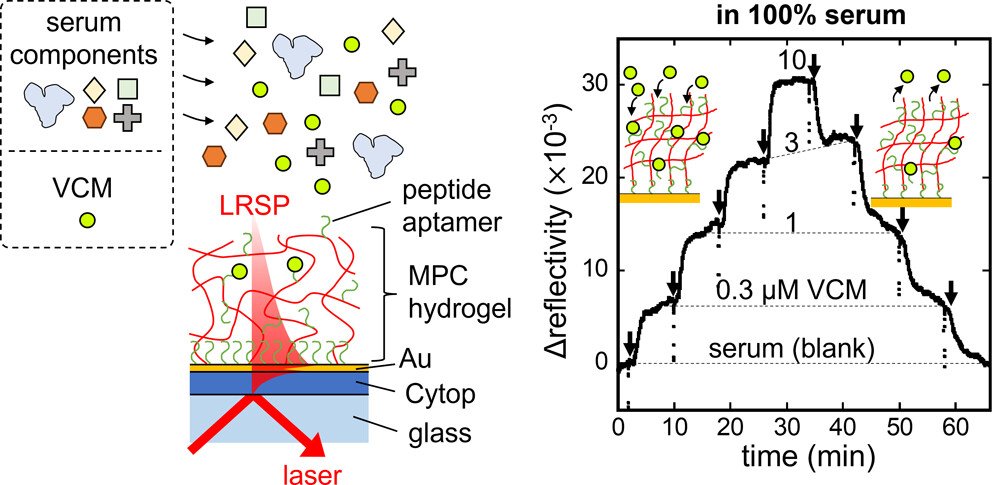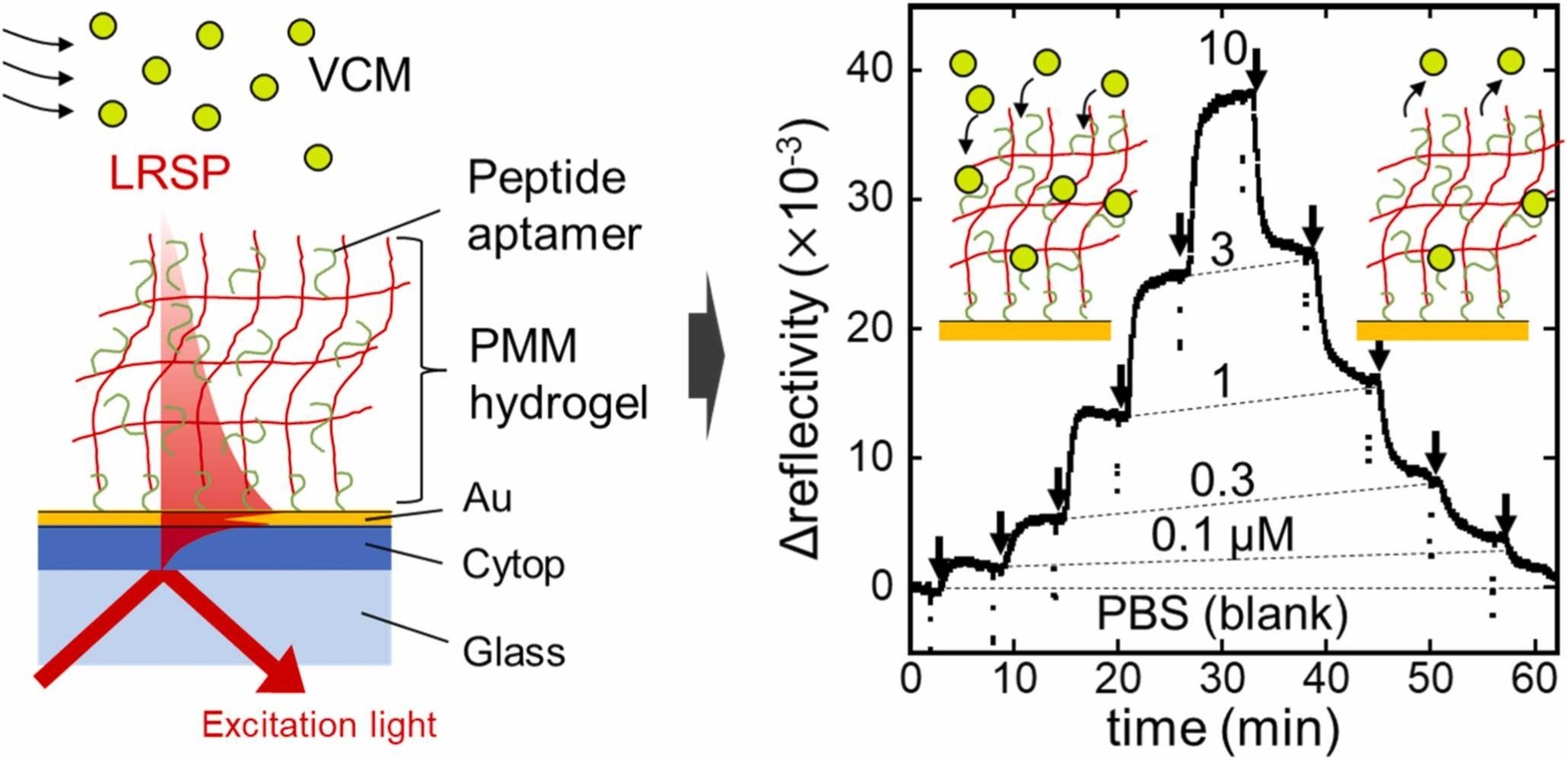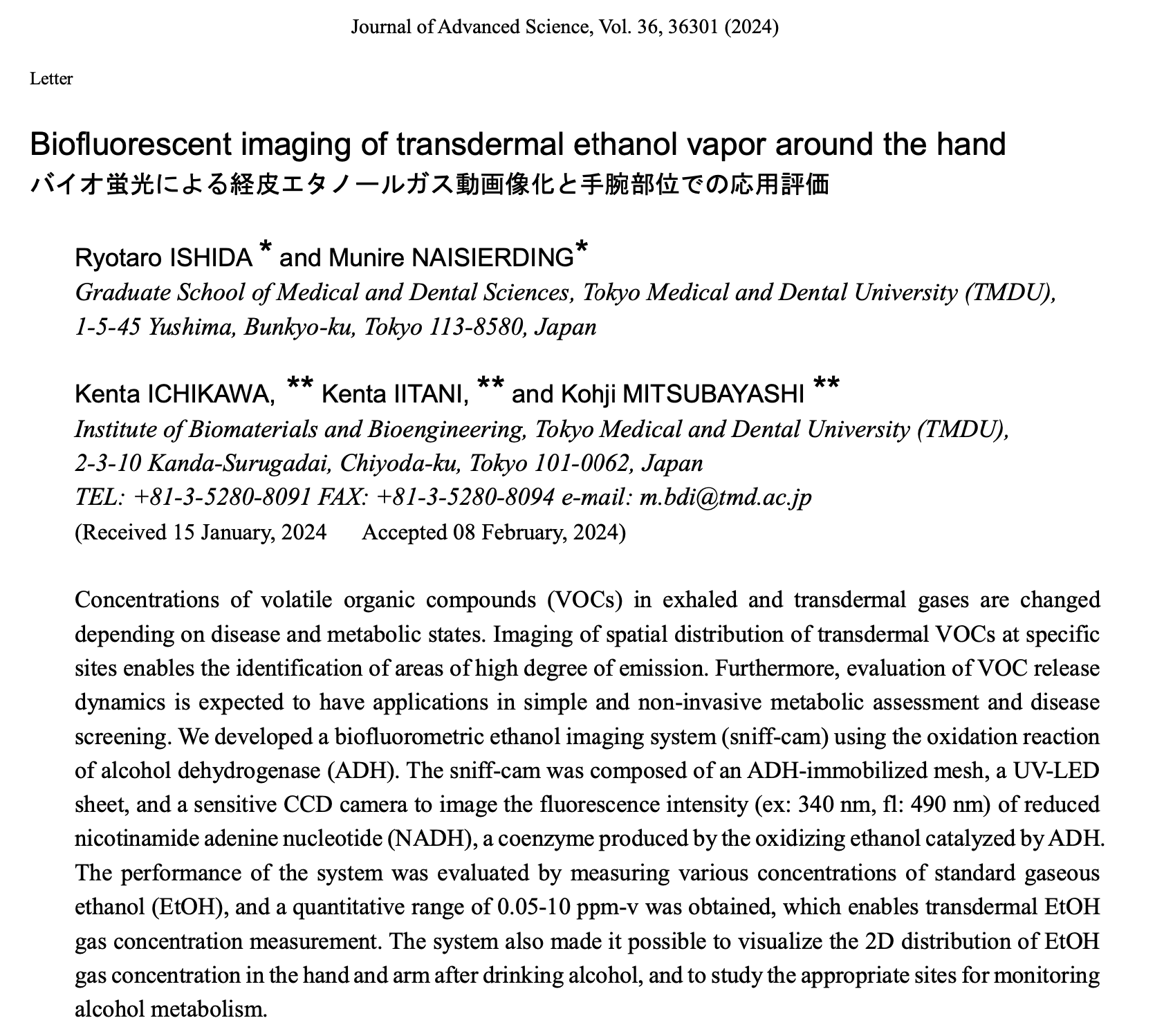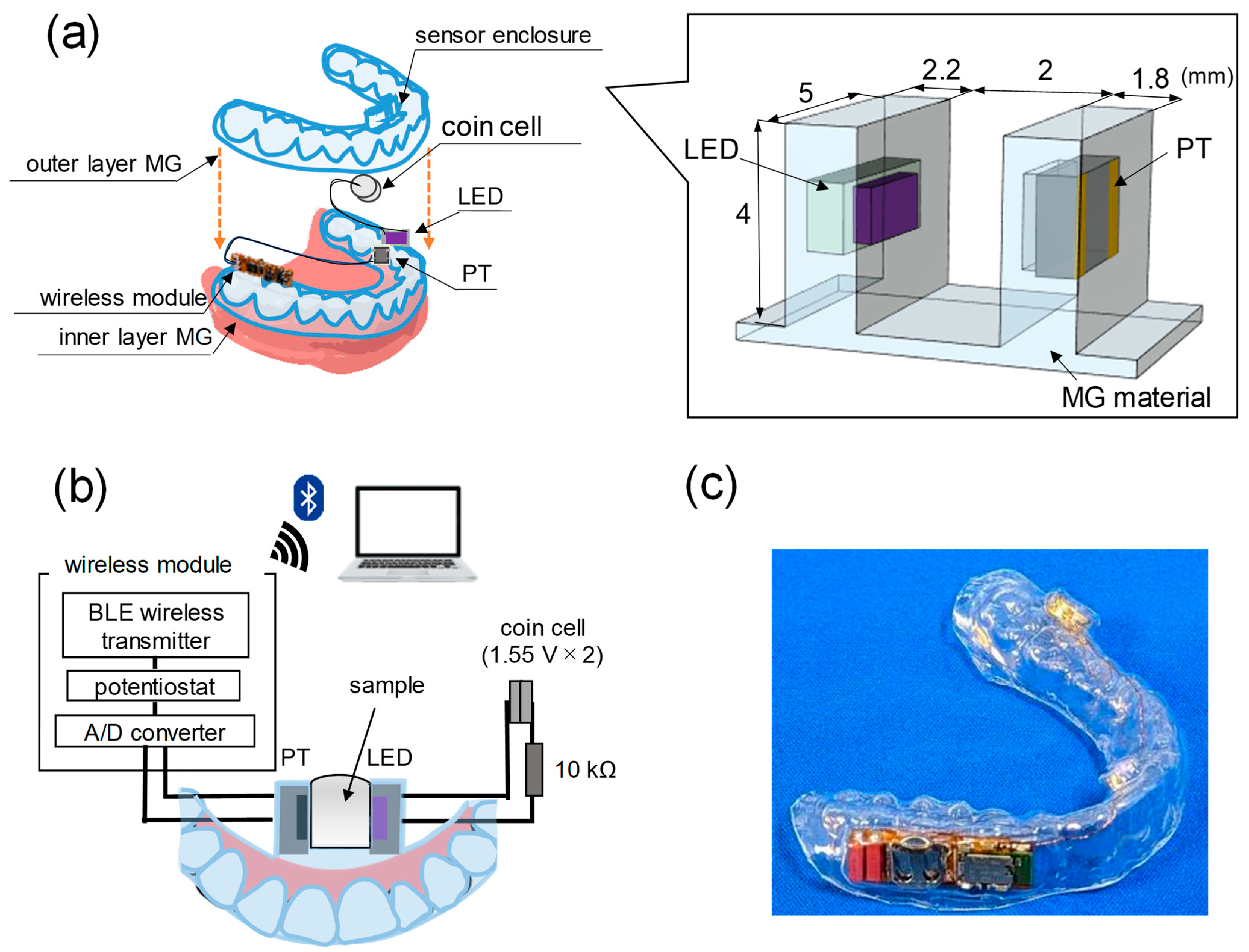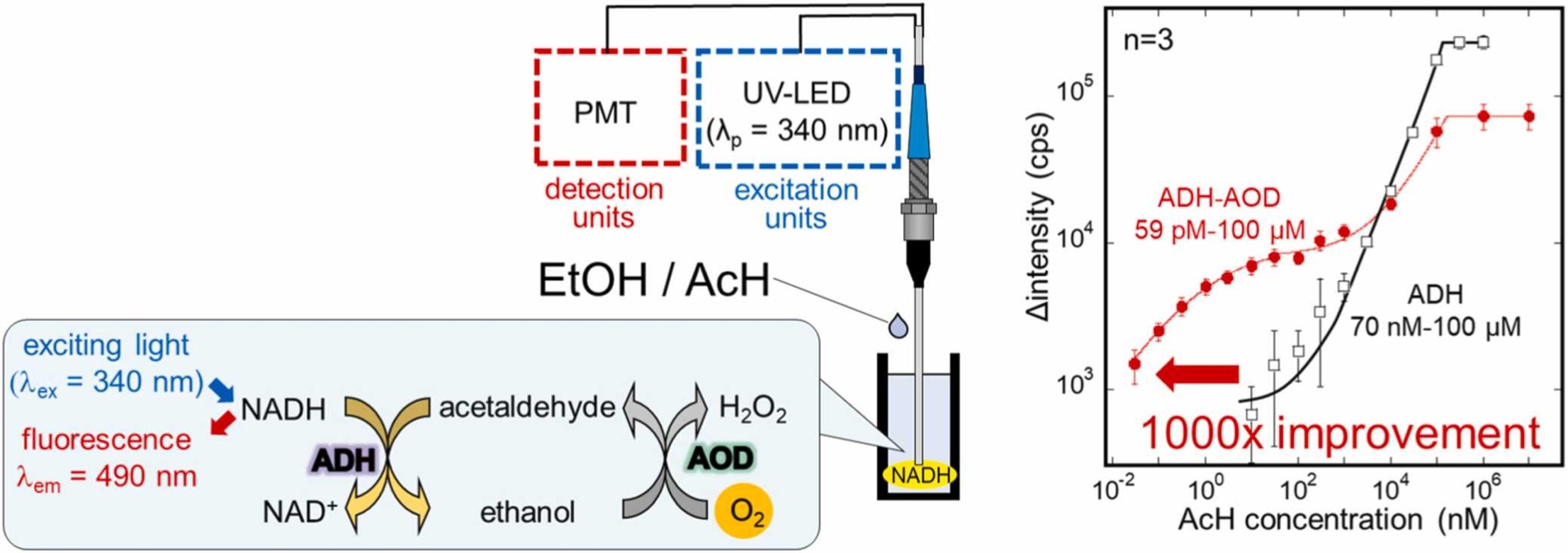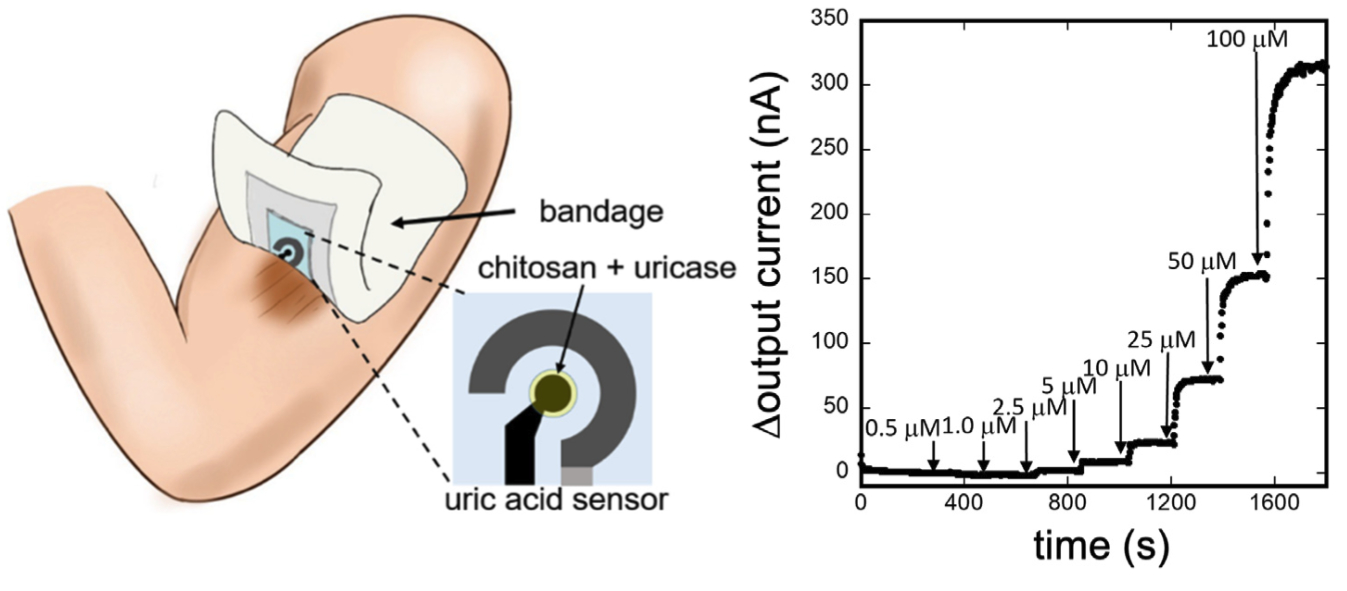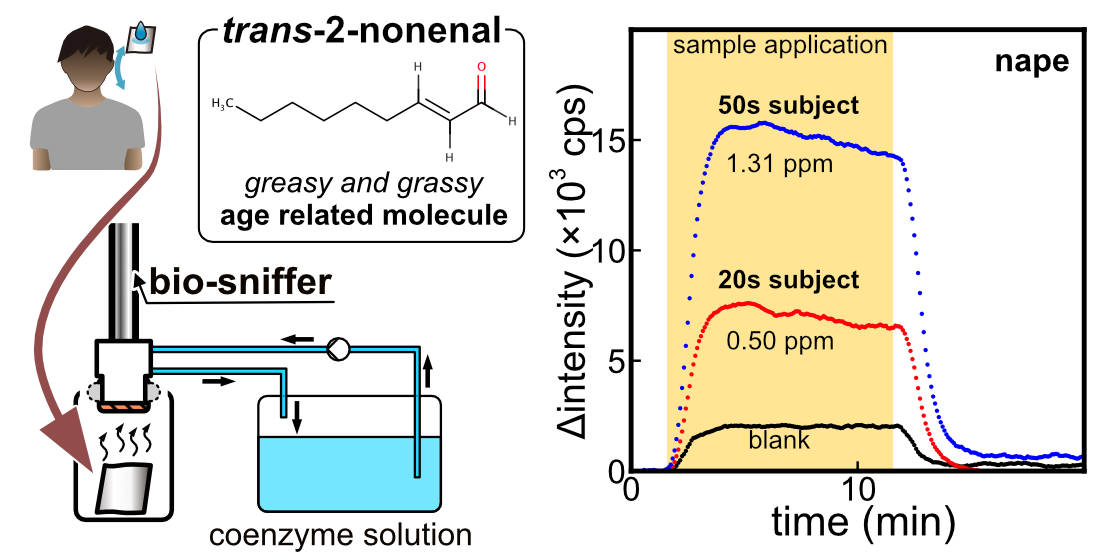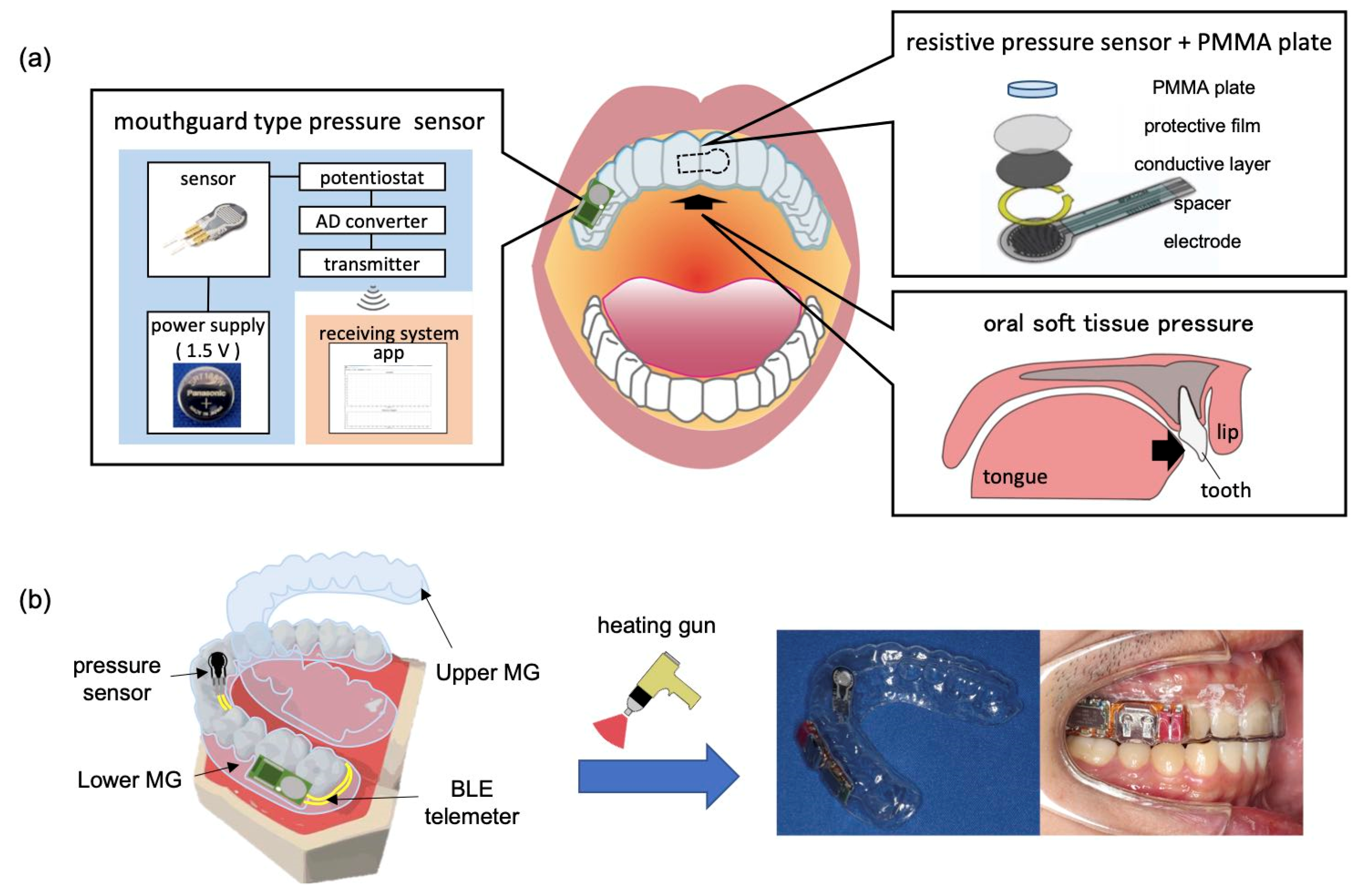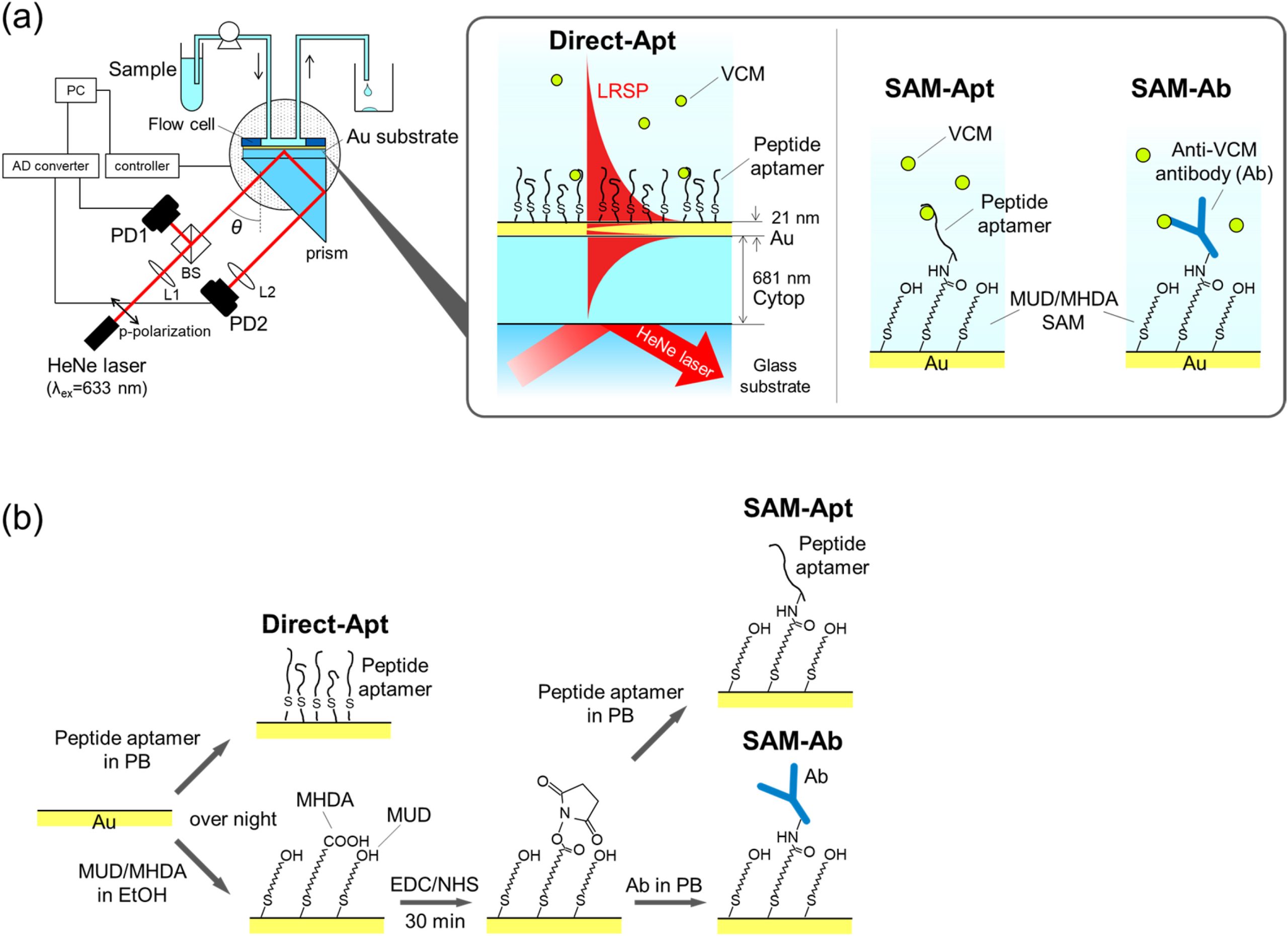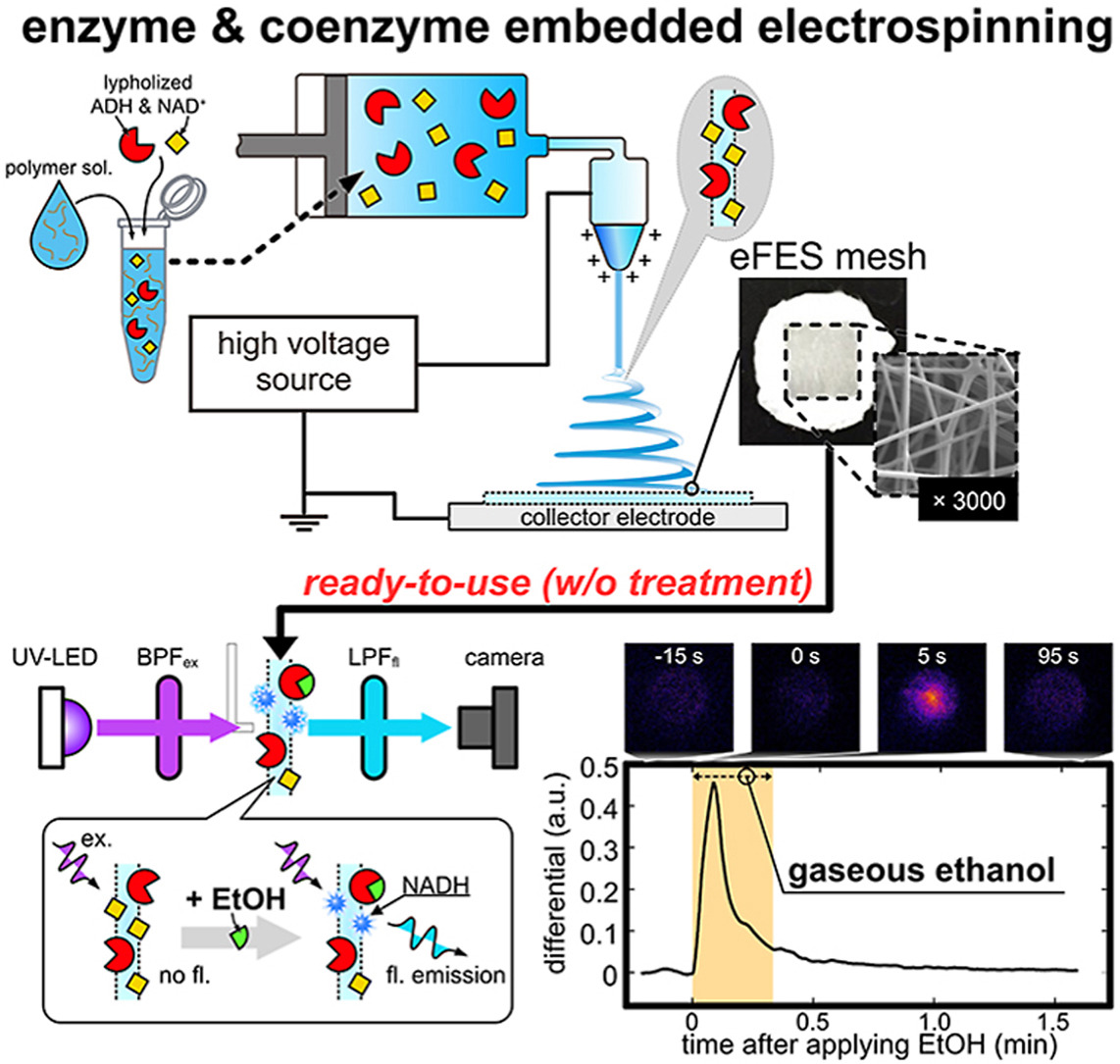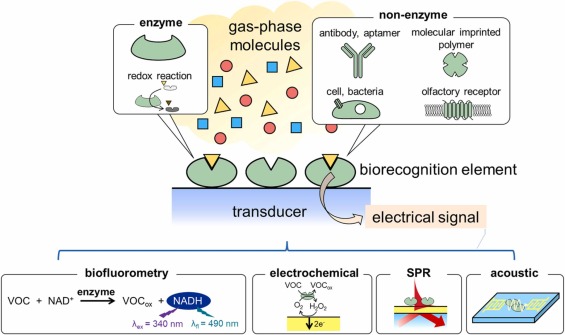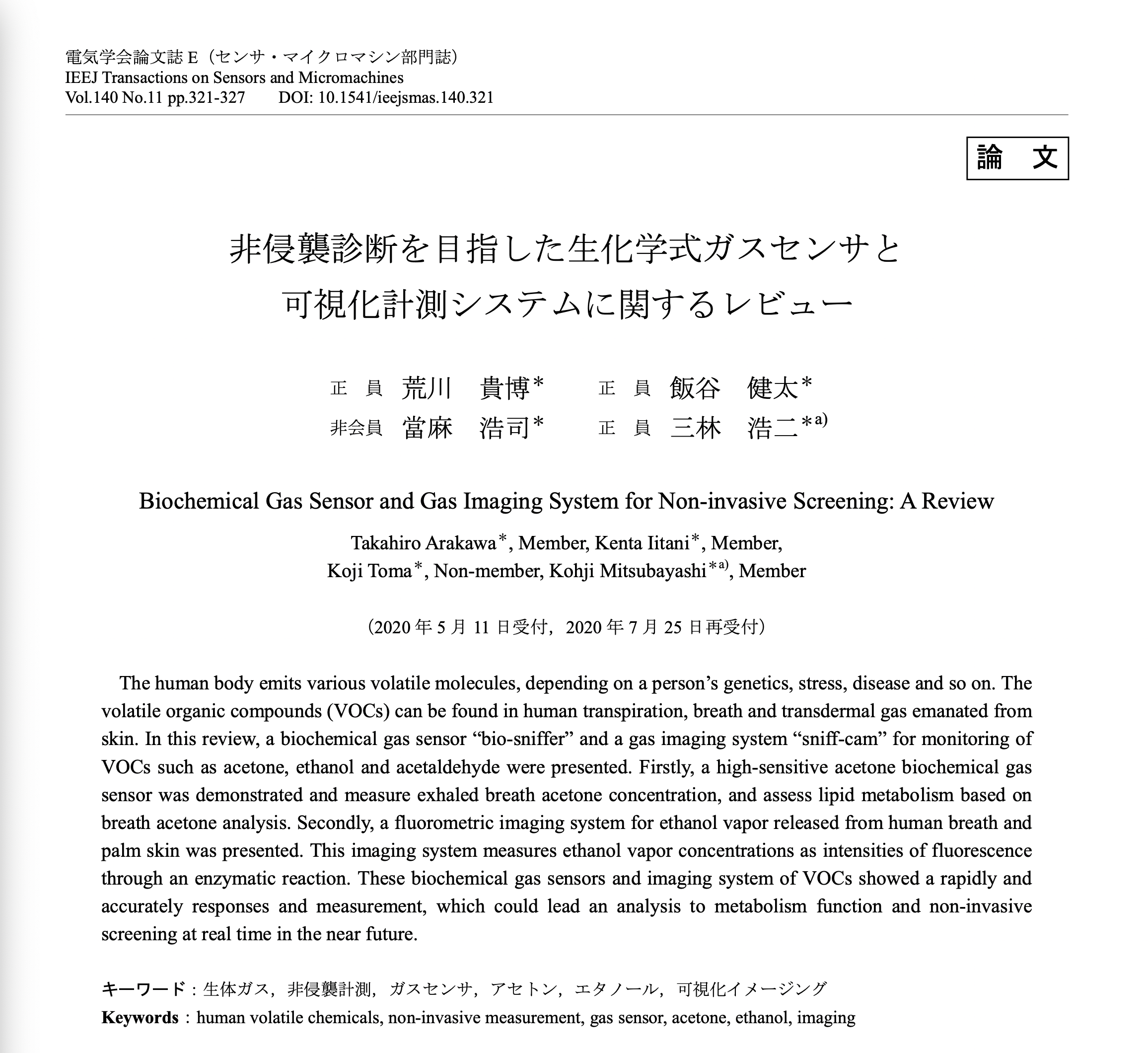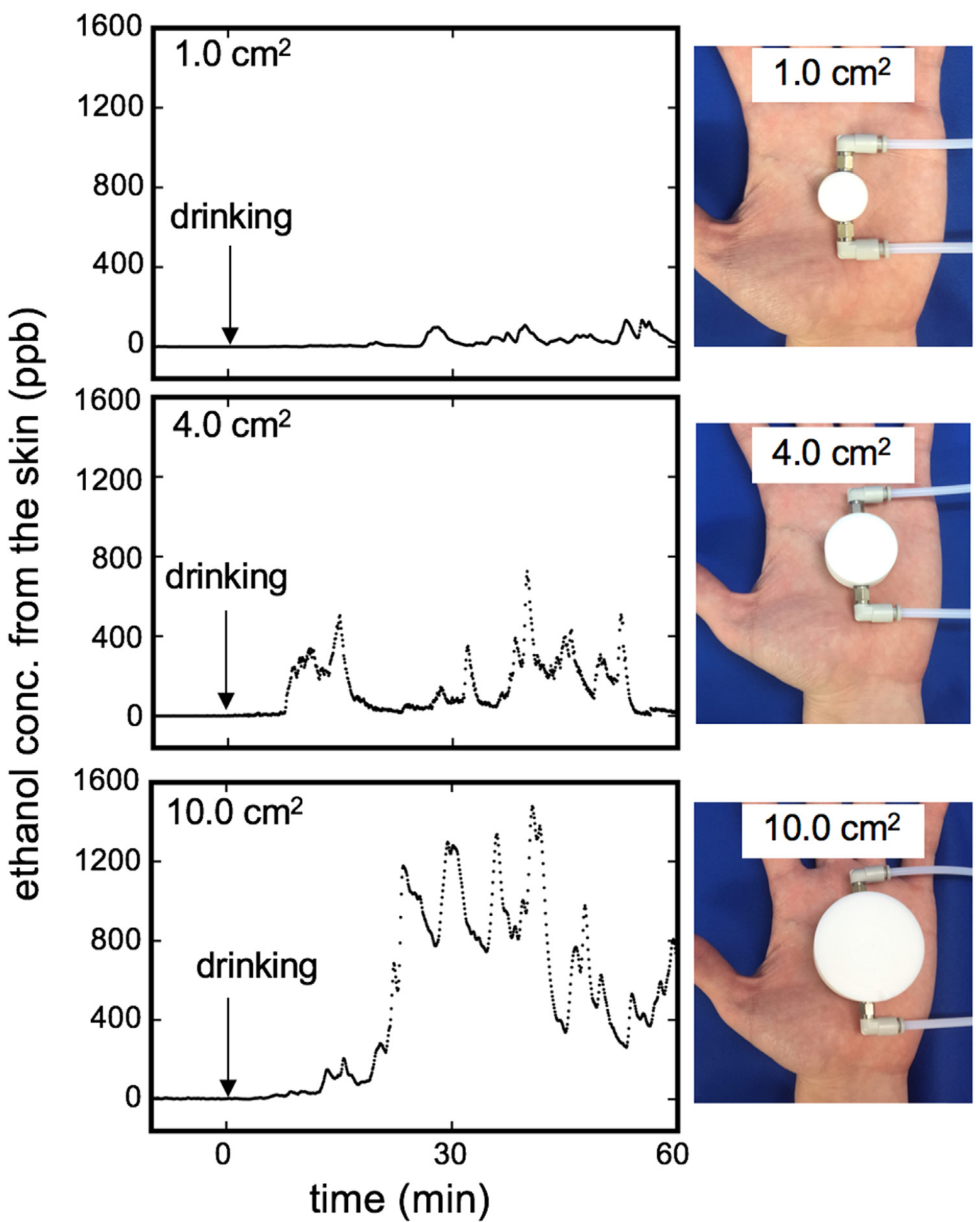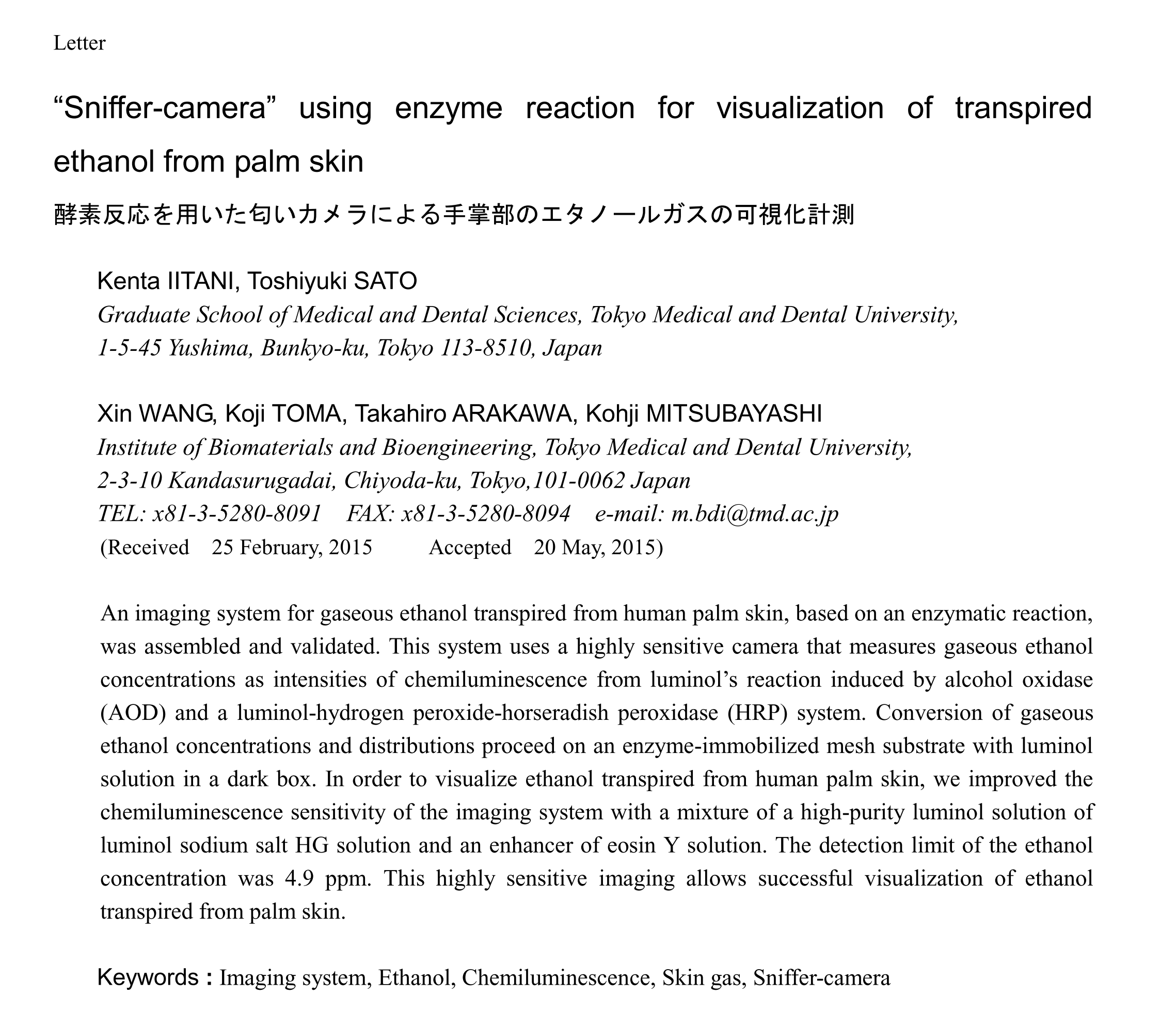Publications
PDF files are available.
Book Chapter
2024
Kenta Iitani, Kenta Ichikawa, Koji Toma, Takahiro Arakawa, Kohji Mitusbayashi
Comprehensive Analytical Chemistry
In: Wasilewski, Tomasz (Ed.): Elsevier, 2024.
@inbook{Iitani2024f,
title = {Comprehensive Analytical Chemistry},
author = {Kenta Iitani, Kenta Ichikawa, Koji Toma, Takahiro Arakawa, Kohji Mitusbayashi},
editor = {Tomasz Wasilewski},
url = {https://www.sciencedirect.com/science/article/pii/S0166526X24001454},
doi = {10.1016/bs.coac.2024.11.004},
year = {2024},
date = {2024-12-03},
urldate = {2024-12-03},
publisher = {Elsevier},
keywords = {},
pubstate = {published},
tppubtype = {inbook}
}
Kenta Iitani, Kenta Ichikawa, Kohji Mitsubayashi
In: Chapter 11-8, Nikkei BP, 2024.
@inbook{Iitani2024e,
title = {Technology Roadmap 2025-2034},
author = {Kenta Iitani, Kenta Ichikawa, Kohji Mitsubayashi},
url = {https://project.nikkeibp.co.jp/mirai/techroadall/},
year = {2024},
date = {2024-11-29},
publisher = {Nikkei BP},
chapter = {11-8},
keywords = {},
pubstate = {published},
tppubtype = {inbook}
}
Kenta Iitani, Kenta Ichikawa, Kohji Mitsubayashi
In: Hiroyuki Kagechika Kohji Mitsubayashi, Akio Kishida (Ed.): Chapter 1-1, pp. 3-20, CMC Publishing, 2024, ISBN: 978-4-7813-1821-9.
@inbook{Iitani2024i,
title = {The Forefront of Biomedical Engineering Research : Future Sciences in Biodevices, Biomaterials, and Drug Discovery},
author = {Kenta Iitani, Kenta Ichikawa, Kohji Mitsubayashi},
editor = {Kohji Mitsubayashi, Hiroyuki Kagechika, Akio Kishida},
url = {https://www.cmcbooks.co.jp/products/detail.php?product_id=115719},
isbn = {978-4-7813-1821-9},
year = {2024},
date = {2024-11-13},
urldate = {2024-11-13},
pages = {3-20},
publisher = {CMC Publishing},
chapter = {1-1},
keywords = {},
pubstate = {published},
tppubtype = {inbook}
}
Kenta Ichikawa, Kenta Iitani, Kohji Mitsubayashi
In: Hiroyuki Kagechika Kohji Mitsubayashi, Akio Kishida (Ed.): pp. 85-96, CMC Publishing, 2024, ISBN: 978-4-7813-1821-9.
@inbook{Ichikawa2024d,
title = {The Forefront of Biomedical Engineering Research : Future Sciences in Biodevices, Biomaterials, and Drug Discovery},
author = {Kenta Ichikawa, Kenta Iitani, Kohji Mitsubayashi},
editor = {Kohji Mitsubayashi, Hiroyuki Kagechika, Akio Kishida},
url = {https://www.cmcbooks.co.jp/products/detail.php?product_id=115719},
isbn = {978-4-7813-1821-9},
year = {2024},
date = {2024-11-13},
pages = {85-96},
publisher = {CMC Publishing},
keywords = {},
pubstate = {published},
tppubtype = {inbook}
}
Kohji Mitsubayashi, Munkhjargal Munkhbayar, Kenta Ichikawa, Kenta Iitani, Koji Toma, Takahiro Arakawa
Latest Trends in Blood Glucose Monitoring and Control
In: Chapter 5.3, pp. 175-184, CMC Publishing, 2024, ISBN: 978-4-7813-1812-7.
@inbook{Mitsubayashi2024,
title = {Latest Trends in Blood Glucose Monitoring and Control},
author = {Kohji Mitsubayashi, Munkhjargal Munkhbayar, Kenta Ichikawa, Kenta Iitani, Koji Toma, Takahiro Arakawa},
url = {https://www.cmcbooks.co.jp/products/detail.php?product_id=115603},
isbn = {978-4-7813-1812-7},
year = {2024},
date = {2024-07-22},
pages = {175-184},
publisher = {CMC Publishing},
chapter = {5.3},
keywords = {},
pubstate = {published},
tppubtype = {inbook}
}
Kenta Ichikawa, Kenta Iitani, Wataru Hijikata, Kohji Mitsubayashi
次世代ウェアラブルデバイスに向けたフレキシブル・伸縮性エレクトロニクス技術とセンサ開発
In: Chapter 2-8, pp. 192–199, Science & Technology, 2024, ISBN: 9784864283236.
@inbook{Ichikawa2024c,
title = {次世代ウェアラブルデバイスに向けたフレキシブル・伸縮性エレクトロニクス技術とセンサ開発},
author = {Kenta Ichikawa, Kenta Iitani, Wataru Hijikata, Kohji Mitsubayashi},
url = {https://www.science-t.com/book/M090.html},
isbn = {9784864283236},
year = {2024},
date = {2024-06-27},
urldate = {2024-06-27},
pages = {192–199},
publisher = {Science & Technology},
chapter = {2-8},
keywords = {},
pubstate = {published},
tppubtype = {inbook}
}
Kenta Iitani, Kenta Ichikawa, Koji Toma, Takahiro Arakawa, Kohji Mitsubayashi
Recent Trends in Volatile Biomarker Sensing
In: Mitsubayashi, Kohji (Ed.): Chapter 2.9, CMC Publishing, 2024, ISBN: 978-4-7813-1808-0.
@inbook{Iitani2024b,
title = {Recent Trends in Volatile Biomarker Sensing},
author = {Kenta Iitani, Kenta Ichikawa, Koji Toma, Takahiro Arakawa, Kohji Mitsubayashi},
editor = {Kohji Mitsubayashi},
url = {https://www.cmcbooks.co.jp/products/detail.php?product_id=9436},
isbn = {978-4-7813-1808-0},
year = {2024},
date = {2024-06-26},
urldate = {2024-06-26},
publisher = {CMC Publishing},
chapter = {2.9},
keywords = {},
pubstate = {published},
tppubtype = {inbook}
}
Takahiro Arakawa, Kenta Iitani, Koji Toma, Kohji Mitsubayashi
Recent Trends in Volatile Biomarker Sensing
In: Mitsubayashi, Kohji (Ed.): Chapter 1.1, CMC Publishing, 2024, ISBN: 978-4-7813-1808-0.
@inbook{Arakawa2024b,
title = {Recent Trends in Volatile Biomarker Sensing},
author = {Takahiro Arakawa, Kenta Iitani, Koji Toma, Kohji Mitsubayashi},
editor = {Kohji Mitsubayashi},
url = {https://www.cmcbooks.co.jp/products/detail.php?product_id=9436},
isbn = {978-4-7813-1808-0},
year = {2024},
date = {2024-06-26},
publisher = {CMC Publishing},
chapter = {1.1},
keywords = {},
pubstate = {published},
tppubtype = {inbook}
}
Kohji Mitsubayashi, Kenta Ichikawa, Kenta Iitani
Recent Trends in Volatile Biomarker Sensing
In: Mitsubayashi, Kohji (Ed.): Chapter 3.6, CMC Publishing, 2024, ISBN: 978-4-7813-1808-0.
@inbook{Mitsubayashi2024b,
title = {Recent Trends in Volatile Biomarker Sensing},
author = {Kohji Mitsubayashi, Kenta Ichikawa, Kenta Iitani},
editor = {Kohji Mitsubayashi},
url = {https://www.cmcbooks.co.jp/products/detail.php?product_id=9436},
isbn = {978-4-7813-1808-0},
year = {2024},
date = {2024-06-26},
publisher = {CMC Publishing},
chapter = {3.6},
keywords = {},
pubstate = {published},
tppubtype = {inbook}
}
Takahiro Arakawa, Kenta Iitani, Koji Toma, Kohji Mitsubayashi
Wearable Biosensing in Medicine and Healthcare
In: Mitsubayashi, Kohji (Ed.): Chapter 1, pp. 3–17, Springer, 2024, ISBN: 978-981-99-8122-9.
@inbook{Arakawa2024,
title = {Wearable Biosensing in Medicine and Healthcare},
author = {Takahiro Arakawa, Kenta Iitani, Koji Toma, Kohji Mitsubayashi },
editor = {Kohji Mitsubayashi},
url = {https://link.springer.com/chapter/10.1007/978-981-99-8122-9_1},
doi = {10.1007/978-981-99-8122-9_1},
isbn = {978-981-99-8122-9},
year = {2024},
date = {2024-01-04},
urldate = {2024-01-04},
pages = {3–17},
publisher = {Springer},
chapter = {1},
keywords = {},
pubstate = {published},
tppubtype = {inbook}
}
Koji Toma, Kenta Iitani, Takahiro Arakawa, Kohji Mitsubayashi
Wearable Biosensing in Medicine and Healthcare
In: Mitsubayashi, Kohji (Ed.): Chapter 14, pp. 299–313, Springer, 2024, ISBN: 978-981-99-8122-9.
@inbook{Toma2024,
title = {Wearable Biosensing in Medicine and Healthcare},
author = {Koji Toma, Kenta Iitani, Takahiro Arakawa, Kohji Mitsubayashi},
editor = {Kohji Mitsubayashi},
url = {https://link.springer.com/chapter/10.1007/978-981-99-8122-9_14},
doi = {https://link.springer.com/chapter/10.1007/978-981-99-8122-9_14},
isbn = {978-981-99-8122-9},
year = {2024},
date = {2024-01-04},
urldate = {2024-01-04},
pages = {299–313},
publisher = {Springer},
chapter = {14},
keywords = {},
pubstate = {published},
tppubtype = {inbook}
}
Kenta Iitani, Koji Toma, Takahiro Arakawa, Kohji Mitsubayashi
Wearable Biosensing in Medicine and Healthcare
In: Mitsubayashi, Kohji (Ed.): Chapter 20, pp. 475–489, Springer, 2024, ISBN: 978-981-99-8122-9.
@inbook{Iitani2024,
title = {Wearable Biosensing in Medicine and Healthcare},
author = {Kenta Iitani, Koji Toma, Takahiro Arakawa, Kohji Mitsubayashi},
editor = {Kohji Mitsubayashi},
url = {https://link.springer.com/chapter/10.1007/978-981-99-8122-9_20},
doi = {10.1007/978-981-99-8122-9_20},
isbn = {978-981-99-8122-9},
year = {2024},
date = {2024-01-04},
urldate = {2024-01-04},
pages = {475–489},
publisher = {Springer},
chapter = {20},
keywords = {},
pubstate = {published},
tppubtype = {inbook}
}
2023
Kenta Iitani, Kenta Ichikawa, Kohji Mitsubayashi
In: Chapter 10-7, pp. 396–397, Nikkei BP, 2023.
@inbook{Iitani2023d,
title = {Technology Roadmap 2024-2033},
author = {Kenta Iitani, Kenta Ichikawa, Kohji Mitsubayashi},
url = {https://project.nikkeibp.co.jp/mirai/techroadall/},
year = {2023},
date = {2023-11-30},
pages = {396–397},
publisher = {Nikkei BP},
chapter = {10-7},
series = {Overall Inductries},
keywords = {},
pubstate = {published},
tppubtype = {inbook}
}
Kenta Iitani, Kohji Mitsubayashi
In: Chapter 3-4, pp. 103-117, Science and Technology, 2023, ISBN: 978-4-86428-309-0.
@inbook{Iitani2023c,
title = {匂い・香りの科学と評価・可視化・応用技術},
author = {Kenta Iitani, Kohji Mitsubayashi},
isbn = {978-4-86428-309-0},
year = {2023},
date = {2023-07-28},
urldate = {2023-07-28},
pages = {103-117},
publisher = {Science and Technology},
chapter = {3-4},
keywords = {},
pubstate = {published},
tppubtype = {inbook}
}
2022
Kenta Iitani, Kohji Mitsubayashi
In: Chapter 6-9, pp. 274–275, Nikkei BP, 2022.
@inbook{Iitani2022c,
title = {Technology Roadmap 2023-2032},
author = {Kenta Iitani, Kohji Mitsubayashi},
year = {2022},
date = {2022-11-30},
pages = {274–275},
publisher = {Nikkei BP},
chapter = {6-9},
series = {Overall Industries},
keywords = {},
pubstate = {published},
tppubtype = {inbook}
}
Takahiro Arakawa, Kenta Iitani, Koji Toma, Kohji Mitsubayashi
Encyclopedia of Sensors and Biosensors
In: Roger Narayan, Kazunori Ikebukuro (Ed.): vol. 1, Chapter Biosensors: Gas Sensors, pp. 478–504, Elsevier, 2022.
@inbook{Arakawa2022c,
title = {Encyclopedia of Sensors and Biosensors},
author = {Takahiro Arakawa, Kenta Iitani, Koji Toma, Kohji Mitsubayashi},
editor = {Roger Narayan, Kazunori Ikebukuro},
url = {https://www.sciencedirect.com/science/article/pii/B9780128225486000662},
doi = {10.1016/B978-0-12-822548-6.00066-2},
year = {2022},
date = {2022-10-03},
urldate = {2022-10-03},
volume = {1},
pages = {478–504},
publisher = {Elsevier},
chapter = {Biosensors: Gas Sensors},
abstract = {In this review, we introduce various gas biosensors, including enzyme-based, cell-based, and biochemical detection methods. Exhaled breath and skin gas in humans contain volatile organic compounds (VOCs) that emanate from components of the blood. These compounds can be products of metabolism or disease; therefore, the measurement of human skin and breath volatiles could be a useful and convenient method for non-invasive disease screening in the future.},
keywords = {},
pubstate = {published},
tppubtype = {inbook}
}
Kohji MItsubayashi, Kenta Iitani, Koji Toma, Takahiro Arakawa
Forefront of the Science of Palatability and their Business
In: Toko, Kiyoshi; Kashiwayanagi, Makoto (Ed.): Chapter 5, pp. 107–119, CMC Publishing, 2022, ISBN: 978-4-7813-1675-8.
@inbook{MItsubayashi2022b,
title = {Forefront of the Science of Palatability and their Business},
author = {Kohji MItsubayashi, Kenta Iitani, Koji Toma, Takahiro Arakawa},
editor = {Kiyoshi Toko and Makoto Kashiwayanagi},
url = {https://www.cmcbooks.co.jp/products/detail.php?product_id=8633},
isbn = {978-4-7813-1675-8},
year = {2022},
date = {2022-08-10},
pages = {107–119},
publisher = {CMC Publishing},
chapter = {5},
keywords = {},
pubstate = {published},
tppubtype = {inbook}
}
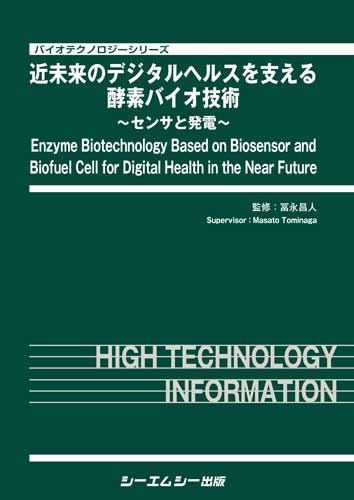
Takahiro Arakawa, Kenta Iitani, Koji Toma, Kohji Mitsubayashi
Enzyme Biotechnology Based on Biosensor and Biofuel Cell for Digital Health in the Near Future
In: Chapter 3, pp. 160-170, CMC Publishing, 2022, ISBN: 978-4-7813-1660-4.
@inbook{Arakawa2022,
title = {Enzyme Biotechnology Based on Biosensor and Biofuel Cell for Digital Health in the Near Future},
author = {Takahiro Arakawa, Kenta Iitani, Koji Toma, Kohji Mitsubayashi},
url = {https://www.cmcbooks.co.jp/products/detail.php?product_id=8498},
isbn = {978-4-7813-1660-4},
year = {2022},
date = {2022-02-17},
pages = {160-170},
publisher = {CMC Publishing},
chapter = {3},
keywords = {},
pubstate = {published},
tppubtype = {inbook}
}
2021
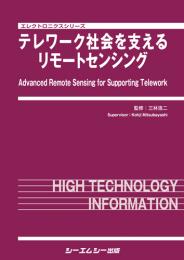
Kenta Iitani, Koji Toma, Takahiro Arakawa, Kohji Mitsubayashi
Advanced Remote Sensing for Supporting Telework
In: Chapter 6, pp. 59-70, CMC Publishing, 2021, ISBN: 978-4-7813-1602-4.
@inbook{Iitani2021b,
title = {Advanced Remote Sensing for Supporting Telework},
author = {Kenta Iitani, Koji Toma, Takahiro Arakawa, Kohji Mitsubayashi},
url = {https://www.cmcbooks.co.jp/products/detail.php?product_id=8098},
isbn = {978-4-7813-1602-4},
year = {2021},
date = {2021-04-26},
pages = {59-70},
publisher = {CMC Publishing},
chapter = {6},
keywords = {},
pubstate = {published},
tppubtype = {inbook}
}
2020
Kenta Iitani, Takahiro Arakawa, Koji Toma, Kohji Mitsubayashi
In: Chapter 3, pp. 23–35, CMC Publishing, 2020, ISBN: 978-4-7813-1488-4.
@inbook{Iitani2020b,
title = {Enzyme Transducers and Evolutions of Enzymatic Technology―Enzyme Sensors, Bio Batteries and Novel Enzymatic Approaches (Food, Medicine, Restoring) ―},
author = {Kenta Iitani and Takahiro Arakawa and Koji Toma and Kohji Mitsubayashi},
url = {https://www.cmcbooks.co.jp/products/detail.php?product_id=6041},
isbn = {978-4-7813-1488-4},
year = {2020},
date = {2020-03-01},
pages = {23–35},
publisher = {CMC Publishing},
chapter = {3},
keywords = {},
pubstate = {published},
tppubtype = {inbook}
}
Journal Article
2025
Rihito Inaba, Hidehisa Mori, Kenta Ichikawa, Kenta Iitani, Kohji Mitsubayashi
Evaluation of enone reductase-based biofluorometric sensor for measurement of trans-2-nonenal
In: Journal of Advanced Science, vol. 37, pp. 37301-1-37301-3, 2025, (Letter).
@article{Inaba2025,
title = {Evaluation of enone reductase-based biofluorometric sensor for measurement of trans-2-nonenal},
author = {Rihito Inaba, Hidehisa Mori, Kenta Ichikawa, Kenta Iitani, Kohji Mitsubayashi},
url = {https://doi.org/10.2978/jsas.37301
https://iitani.com/wp-content/uploads/2025/06/37_37301-2.pdf},
doi = {10.2978/jsas.37301},
year = {2025},
date = {2025-05-08},
urldate = {2025-05-08},
journal = {Journal of Advanced Science},
volume = {37},
pages = {37301-1-37301-3},
note = {Letter},
keywords = {},
pubstate = {published},
tppubtype = {article}
}
Yuichiro Hosomi, Naohiro Ishizuki, Kenta Ichikawa, Kenta Iitani, Kohji Mitsubayashi
In: Journal of Advanced Science, vol. 37, pp. 37302-1-37302-3, 2025, (Letter).
@article{Hosomi2025,
title = {Evaluation of the accuracy of sub-ppb level acetone standard gas and highly sensitive acetone bio-sniffer by using gas chromatography-mass spectrometry},
author = {Yuichiro Hosomi, Naohiro Ishizuki, Kenta Ichikawa, Kenta Iitani, Kohji Mitsubayashi},
url = {https://doi.org/10.2978/jsas.37302
https://iitani.com/wp-content/uploads/2025/06/37_37302.pdf},
doi = {10.2978/jsas.37302},
year = {2025},
date = {2025-05-08},
journal = {Journal of Advanced Science},
volume = {37},
pages = {37302-1-37302-3},
note = {Letter},
keywords = {},
pubstate = {published},
tppubtype = {article}
}
Kenta Ichikawa, Kenta Iitani, Yumin Zhao, Koji Toma, Takahiro Arakawa, Kohji Mitsubayashi
A Mouthguard-type Biosensor for Direct Measurement of Glucose Intake in Drinks
In: Sensors and Materials, vol. 37, iss. 4, pp. 1569, 2025, (Kenta Ichikawa and Kenta Iitani contributed equally to this work.).
@article{Ichikawa2025,
title = {A Mouthguard-type Biosensor for Direct Measurement of Glucose Intake in Drinks},
author = {Kenta Ichikawa, Kenta Iitani, Yumin Zhao, Koji Toma, Takahiro Arakawa, Kohji Mitsubayashi},
url = {https://doi.org/10.18494/sam5210
https://iitani.com/wp-content/uploads/2025/06/SM4005.pdf},
doi = {10.18494/sam5210},
year = {2025},
date = {2025-04-22},
urldate = {2025-04-22},
journal = {Sensors and Materials},
volume = {37},
issue = {4},
pages = {1569},
note = {Kenta Ichikawa and Kenta Iitani contributed equally to this work.},
keywords = {},
pubstate = {published},
tppubtype = {article}
}
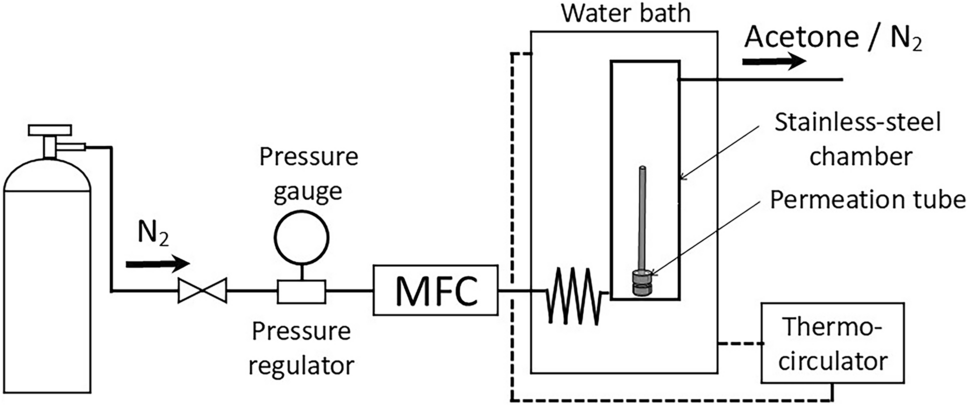
Reiji Aoyagi, Takahiro Arakawa, Kenta Iitani, Kohji Mitsubayashi, Yoshika Sekine, Yuichiro Kaifuku
In: Discover Applied Sciences, vol. 7, no. 4, pp. 298, 2025.
@article{Aoyagi2025,
title = {Development of dynamic gas generation system for ultratrace amounts of acetone at parts-per-trillion levels with low temperature permeation method},
author = {Reiji Aoyagi, Takahiro Arakawa, Kenta Iitani, Kohji Mitsubayashi, Yoshika Sekine, Yuichiro Kaifuku},
url = {https://link.springer.com/article/10.1007/s42452-025-06722-x
https://iitani.com/wp-content/uploads/2025/04/Aoyagi-et-al._2025_Development-of-dynamic-ga.pdf},
doi = {10.1007/s42452-025-06722-x},
year = {2025},
date = {2025-04-03},
urldate = {2025-04-03},
journal = {Discover Applied Sciences},
volume = {7},
number = {4},
pages = {298},
keywords = {},
pubstate = {published},
tppubtype = {article}
}
Geng Zhang, Kenta Ichikawa, Kenta Iitani, Yasuhiko Iwasaki, Kohji Mitsubayashi
Headset biofluorometric system for acetone vapor from the ear canal
In: Sensors and Actuators B: Chemical, vol. 427, pp. 137220, 2025.
@article{Zhang2025,
title = {Headset biofluorometric system for acetone vapor from the ear canal},
author = {Geng Zhang, Kenta Ichikawa, Kenta Iitani, Yasuhiko Iwasaki, Kohji Mitsubayashi},
url = {https://www.sciencedirect.com/science/article/pii/S0925400524019506?dgcid=coauthor},
doi = {10.1016/j.snb.2024.137220},
year = {2025},
date = {2025-03-15},
urldate = {2025-03-15},
journal = {Sensors and Actuators B: Chemical},
volume = {427},
pages = {137220},
keywords = {},
pubstate = {published},
tppubtype = {article}
}
2024
Geng Zhang, Kenta Ichikawa, Kenta Iitani, Yasuhiko Iwasaki, Kohji Mitsubayashi
Handheld biofluorometric system for acetone in the exhaled breath condensates
In: Analyst, 2024.
@article{Zhang2024b,
title = {Handheld biofluorometric system for acetone in the exhaled breath condensates },
author = {Geng Zhang, Kenta Ichikawa, Kenta Iitani, Yasuhiko Iwasaki, Kohji Mitsubayashi},
url = {https://pubs.rsc.org/en/Content/ArticleLanding/2025/AN/D4AN01281J},
doi = {10.1039/D4AN01281J},
year = {2024},
date = {2024-12-19},
urldate = {2024-12-19},
journal = {Analyst},
keywords = {},
pubstate = {published},
tppubtype = {article}
}
Kenta Iitani, Naohiro Ishizuki, Yuka Matsuhashi, Kumi Yokota, Kenta Ichikawa, Koji Toma, Takahiro Arakawa, Yasuhiko Iwasaki, Kohji Mitsubayashi
Biofluorometric Acetone Gas Sensor of Sub-ppbv Level Sensitivity
In: Analytical Chemistry, 2024.
@article{Iitani2024h,
title = {Biofluorometric Acetone Gas Sensor of Sub-ppbv Level Sensitivity},
author = {Kenta Iitani, Naohiro Ishizuki, Yuka Matsuhashi, Kumi Yokota, Kenta Ichikawa, Koji Toma, Takahiro Arakawa, Yasuhiko Iwasaki, Kohji Mitsubayashi},
url = {https://pubs.acs.org/doi/10.1021/acs.analchem.4c03816},
doi = {10.1021/acs.analchem.4c03816},
year = {2024},
date = {2024-12-13},
urldate = {2024-12-13},
journal = {Analytical Chemistry},
keywords = {},
pubstate = {published},
tppubtype = {article}
}
Kenta Iitani, Rintaro Miura, Jihu Lim, Ryotaro Ishida, Kenta Ichikawa, Koji Toma, Takahiro Arakawa, Kohji Mitsubayashi
Tandem Imaging of Breath Ethanol and Acetaldehyde Based on Multiwavelength Enzymatic Biofluorometry
In: ACS Sensors, 2024.
@article{Iitani2024g,
title = {Tandem Imaging of Breath Ethanol and Acetaldehyde Based on Multiwavelength Enzymatic Biofluorometry},
author = {Kenta Iitani, Rintaro Miura, Jihu Lim, Ryotaro Ishida, Kenta Ichikawa, Koji Toma, Takahiro Arakawa, Kohji Mitsubayashi},
url = {https://pubs.acs.org/doi/10.1021/acssensors.4c02451},
doi = {10.1021/acssensors.4c02451},
year = {2024},
date = {2024-12-05},
urldate = {2024-12-05},
journal = {ACS Sensors},
keywords = {},
pubstate = {published},
tppubtype = {article}
}
Kenta IItani, Mika Suzuki, Kenta Ichikawa, Koji Toma, Takahiro Arakawa, Kohji Mitsubayashi
In: Analytical Chemistry, 2024.
@article{IItani2024d,
title = {Image sensing of gaseous acetone using secondary alcohol dehydrogenase-immobilized mesh for exhaled air},
author = {Kenta IItani, Mika Suzuki, Kenta Ichikawa, Koji Toma, Takahiro Arakawa, Kohji Mitsubayashi},
url = {https://pubs.acs.org/doi/full/10.1021/acs.analchem.4c02251},
doi = {10.1021/acs.analchem.4c02251},
year = {2024},
date = {2024-07-03},
urldate = {2024-07-03},
journal = {Analytical Chemistry},
keywords = {},
pubstate = {published},
tppubtype = {article}
}
Kenta Ichikawa, Kenta Iitani, Gentaro Kawase, Koji Toma, Takahiro Arakawa, Dzung Viet Dao, Kohji Mitsubayashi
Real-time salivary turbidity measurement with a mouthguard-type wearable sensor
In: Sensors and Actuators A: Physical, vol. 376, pp. 115660, 2024, (Kenta Ichikawa and Kenta Iitani contributed equally to this work.).
@article{Ichikawa2024b,
title = {Real-time salivary turbidity measurement with a mouthguard-type wearable sensor},
author = {Kenta Ichikawa, Kenta Iitani, Gentaro Kawase, Koji Toma, Takahiro Arakawa, Dzung Viet Dao, Kohji Mitsubayashi},
url = {https://doi.org/10.1016/j.sna.2024.115660},
doi = {10.1016/j.sna.2024.115660},
year = {2024},
date = {2024-06-28},
urldate = {2024-06-28},
journal = {Sensors and Actuators A: Physical},
volume = {376},
pages = {115660},
note = {Kenta Ichikawa and Kenta Iitani contributed equally to this work.},
keywords = {},
pubstate = {published},
tppubtype = {article}
}
Kenta Iitani, Kenta Ichikawa, Koji Toma, Takahiro Arakawa, Kohji Mitsubayashi
In: ACS Sensors, 2024, (This paper was selected for a journal front cover.).
@article{Iitani2024c,
title = {Biofluorometric Gas-Imaging System for Evaluating the Ripening Stages of “La France” Pear Based on Ethanol Vapor Emitted via the Epicarp},
author = {Kenta Iitani, Kenta Ichikawa, Koji Toma, Takahiro Arakawa, Kohji Mitsubayashi},
url = {https://pubs.acs.org/doi/full/10.1021/acssensors.4c00642},
doi = {10.1021/acssensors.4c00642},
year = {2024},
date = {2024-06-25},
urldate = {2024-06-25},
journal = {ACS Sensors},
note = {This paper was selected for a journal front cover.},
keywords = {},
pubstate = {published},
tppubtype = {article}
}
Mari Nagasawa, Mai Onuki, Natsuki Imoto, Kazuomi Tanaka, Ryo Tanaka, Moeka Kawada, Keiichi Imato, Kenta Iitani, Yuji Tsuchido, Naoya Takaeda
In: Biofabrication, vol. 16, pp. 035029, 2024.
@article{Nagasawa2024,
title = {Fabrication of 3D engineered intestinal tissue producing abundant mucus by air-liquid interface culture using paper-based dual-layer scaffold},
author = {Mari Nagasawa, Mai Onuki, Natsuki Imoto, Kazuomi Tanaka, Ryo Tanaka, Moeka Kawada, Keiichi Imato, Kenta Iitani, Yuji Tsuchido, Naoya Takaeda},
url = {https://iopscience.iop.org/article/10.1088/1758-5090/ad504b},
doi = {10.1088/1758-5090/ad504b},
year = {2024},
date = {2024-05-23},
urldate = {2024-05-23},
journal = {Biofabrication},
volume = {16},
pages = {035029},
keywords = {},
pubstate = {published},
tppubtype = {article}
}
Yui Taguchi, Koji Toma, Kenta Iitani, Takahiro Arakawa, Yasuhiko Iwasaki, Kohji Mitsubayashi
In: ACS Applied Materials & Interfaces, vol. 16, iss. 22, pp. 28162–28171, 2024.
@article{Taguchi2024b,
title = {In Vitro Performance of a Long-Range Surface Plasmon Hydrogel Aptasensor for Continuous and Real-Time Vancomycin Measurement in Human Serum},
author = {Yui Taguchi, Koji Toma, Kenta Iitani, Takahiro Arakawa, Yasuhiko Iwasaki, Kohji Mitsubayashi},
url = {https://pubs.acs.org/doi/full/10.1021/acsami.4c03805},
doi = {10.1021/acsami.4c03805},
year = {2024},
date = {2024-05-20},
urldate = {2024-05-20},
journal = {ACS Applied Materials & Interfaces},
volume = {16},
issue = {22},
pages = {28162–28171},
keywords = {},
pubstate = {published},
tppubtype = {article}
}
Yui Taguchi, Koji Toma, Kenta Iitani, Takahiro Arakawa, Yasuhiko Iwasaki, Kohji Mitsubayashi
In: Sensors and Actuators B: Chemical, vol. 413, pp. 135882, 2024.
@article{Taguchi2024,
title = {Long-range surface plasmon hydrogel aptasensor for sensitive, selective, and continuous measurement of vancomycin},
author = {Yui Taguchi, Koji Toma, Kenta Iitani, Takahiro Arakawa, Yasuhiko Iwasaki, Kohji Mitsubayashi},
url = {https://www.sciencedirect.com/science/article/pii/S0925400524006129},
doi = {10.1016/j.snb.2024.135882},
year = {2024},
date = {2024-04-29},
journal = {Sensors and Actuators B: Chemical},
volume = {413},
pages = {135882},
keywords = {},
pubstate = {published},
tppubtype = {article}
}
Ryotaro Ishida, Munire Naisierding, Kenta Ichikawa, Kenta Iitani, Kohji Mitsubayashi
Biofluorescent imaging of transdermal ethanol vapor around the hand
In: Journal of Advanced Science, vol. 36, pp. 36301, 2024.
@article{Ishida2024,
title = {Biofluorescent imaging of transdermal ethanol vapor around the hand},
author = {Ryotaro Ishida, Munire Naisierding, Kenta Ichikawa, Kenta Iitani, Kohji Mitsubayashi},
url = {https://doi.org/10.2978/jsas.36301},
doi = {10.2978/jsas.36301},
year = {2024},
date = {2024-04-15},
journal = {Journal of Advanced Science},
volume = {36},
pages = {36301},
keywords = {},
pubstate = {published},
tppubtype = {article}
}
Kenta Ichikawa, Kenta Iitani, Gentaro Kawase, Koji Toma, Takahiro Arakawa, Dzung Viet Dao, Kohji Mitsubayashi
Mouthguard-Type Wearable Sensor for Monitoring Salivary Turbidity to Assess Oral Hygiene
In: Sensors, vol. 24, iss. 5, pp. 1436, 2024, (Communication. Kenta Ichikawa and Kenta Iitani contributed equally to this work.).
@article{Ichikawa2024,
title = {Mouthguard-Type Wearable Sensor for Monitoring Salivary Turbidity to Assess Oral Hygiene},
author = {Kenta Ichikawa, Kenta Iitani, Gentaro Kawase, Koji Toma, Takahiro Arakawa, Dzung Viet Dao, Kohji Mitsubayashi},
url = {https://www.mdpi.com/1424-8220/24/5/1436
https://iitani.com/wp-content/uploads/2024/02/Ichikawa-et-al_2024_Mouthguard-Type-Wearable.pdf},
doi = {10.3390/s24051436},
year = {2024},
date = {2024-02-23},
urldate = {2024-02-23},
journal = {Sensors},
volume = {24},
issue = {5},
pages = {1436},
note = {Communication. Kenta Ichikawa and Kenta Iitani contributed equally to this work.},
keywords = {},
pubstate = {published},
tppubtype = {article}
}
Geng Zhang, Yuki Maeno, Kenta Iitani, Takahiro Arakawa, Yasuhiko Iwasaki, Koji Toma, Kohji Mitsubayashi
In: Sensors and Actuators B: Chemical, vol. 401, pp. 13531, 2024.
@article{Zhang2024,
title = {Enhanced sensitivity of a fluorometric biosensor for alcohol metabolites with an enzymatic cycling reaction},
author = {Geng Zhang, Yuki Maeno, Kenta Iitani, Takahiro Arakawa, Yasuhiko Iwasaki, Koji Toma, Kohji Mitsubayashi},
url = {https://doi.org/10.1016/j.snb.2023.135031},
doi = {10.1016/j.snb.2023.135031},
year = {2024},
date = {2024-02-15},
urldate = {2024-02-15},
journal = {Sensors and Actuators B: Chemical},
volume = {401},
pages = {13531},
keywords = {},
pubstate = {published},
tppubtype = {article}
}
2023
Mizuki Sato, Tatsuya Kamiyama, Kenta Iitani, Kazuyoshi Yano, Kohji Mitsubayashi
Wearable Biosensor Utilizing Chitosan Biopolymer for Uric Acid Monitoring
In: Journal of Robotics and Mechatronics, vol. 35, iss. 5, pp. 1131-1134, 2023.
@article{Sato2023,
title = {Wearable Biosensor Utilizing Chitosan Biopolymer for Uric Acid Monitoring},
author = {Mizuki Sato, Tatsuya Kamiyama, Kenta Iitani, Kazuyoshi Yano, Kohji Mitsubayashi},
url = {https://doi.org/10.20965/jrm.2023.p1131
https://iitani.com/wp-content/uploads/2023/11/Sato-et-al_2023_Wearable-Biosensor.pdf},
doi = {10.20965/jrm.2023.p1131},
year = {2023},
date = {2023-10-20},
urldate = {2023-10-20},
journal = {Journal of Robotics and Mechatronics},
volume = {35},
issue = {5},
pages = {1131-1134},
keywords = {},
pubstate = {published},
tppubtype = {article}
}
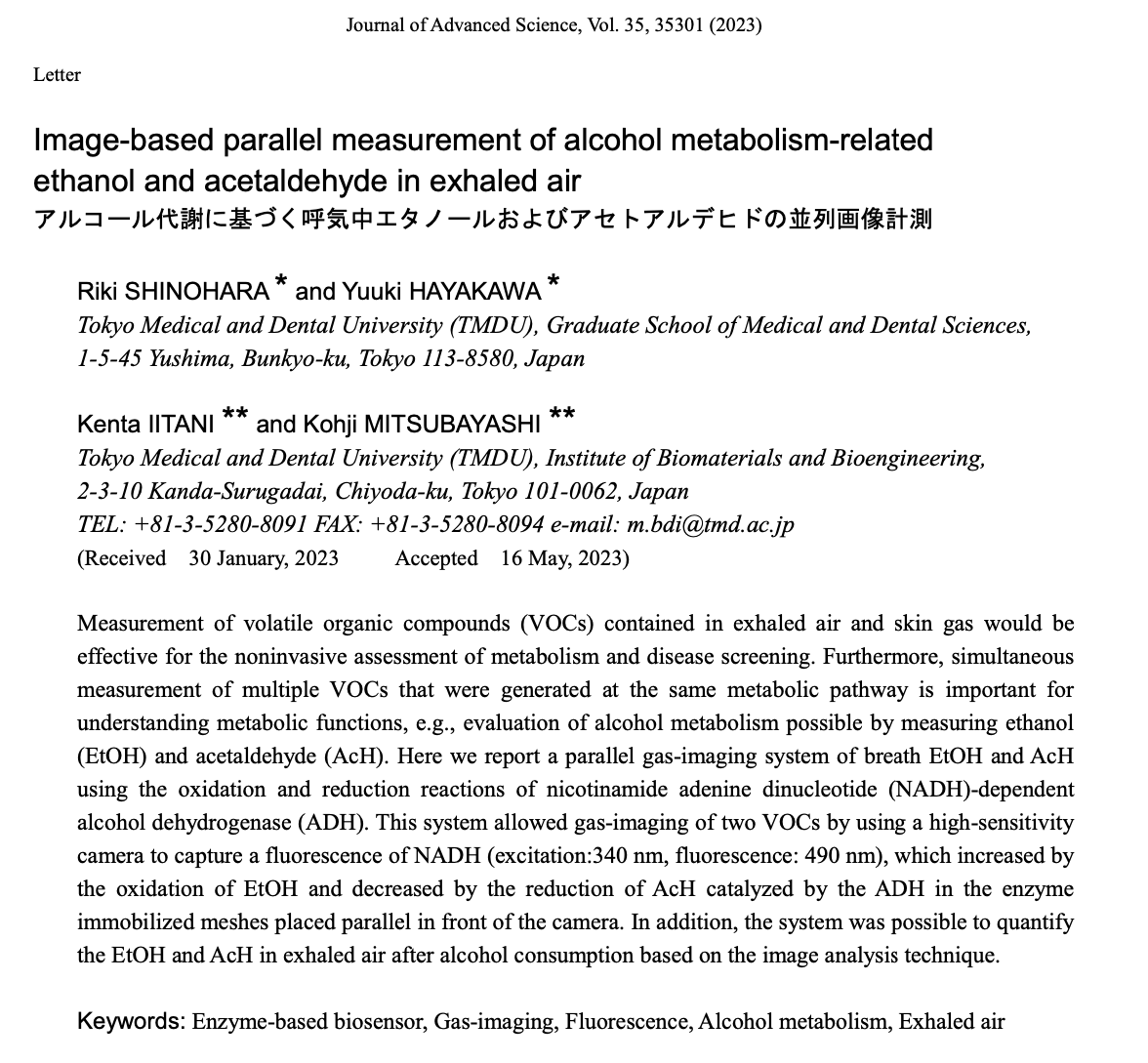
Riki Shinohara, Yuuki Hayakawa, Kenta Iitani, Kohji Mitsubayashi
In: Journal of Advanced Science, vol. 35, iss. 35301, pp. 1-3, 2023, (Letter).
@article{Shinohara2023,
title = {Image-based parallel measurement of alcohol metabolism-related ethanol and acetaldehyde in exhaled air},
author = {Riki Shinohara, Yuuki Hayakawa, Kenta Iitani, Kohji Mitsubayashi},
url = {https://iitani.com/wp-content/uploads/2023/09/Shinohara-et-al_2023_Image-based-parallel.pdf
https://doi.org/10.2978/jsas.35301},
doi = {10.2978/jsas.35301},
year = {2023},
date = {2023-09-01},
urldate = {2023-09-01},
journal = {Journal of Advanced Science},
volume = {35},
issue = {35301},
pages = {1-3},
note = {Letter},
keywords = {},
pubstate = {published},
tppubtype = {article}
}
Kenta Iitani, Hidehisa Mori, Kenta Ichikawa, Koji Toma, Takahiro Arakawa, Yasuhiko Iwasaki, Kohji Mitsubayashi
In: Sensors, vol. 23, iss. 13, pp. 5857, 2023.
@article{Iitani2023b,
title = {Gas-Phase Biosensors (Bio-Sniffers) for Measurement of 2-Nonenal, the Causative Volatile Molecule of Human Aging-Related Body Odor},
author = {Kenta Iitani, Hidehisa Mori, Kenta Ichikawa, Koji Toma, Takahiro Arakawa, Yasuhiko Iwasaki, Kohji Mitsubayashi},
url = {https://www.mdpi.com/1424-8220/23/13/5857
https://iitani.com/wp-content/uploads/2023/06/Iitani-et-al_2023_Gas-Phase-Biosensors.pdf},
doi = {10.3390/s23135857},
year = {2023},
date = {2023-06-24},
urldate = {2023-06-24},
journal = {Sensors},
volume = {23},
issue = {13},
pages = {5857},
keywords = {},
pubstate = {published},
tppubtype = {article}
}
Hidekazu Matsumoto, Keisuke Tomoto, Gentaro Kawase, Kenta Iitani, Koji Toma, Takahiro Arakawa, Kohji Mitsubayashi, Keiji Moriyama
In: Sensors, vol. 23, iss. 11, pp. 5027, 2023.
@article{Matsumoto2023,
title = {Real-Time Continuous Monitoring of Oral Soft Tissue Pressure with a Wireless Mouthguard Device for Assessing Tongue Thrusting Habits},
author = {Hidekazu Matsumoto, Keisuke Tomoto, Gentaro Kawase, Kenta Iitani, Koji Toma, Takahiro Arakawa, Kohji Mitsubayashi, Keiji Moriyama},
url = {https://www.mdpi.com/1424-8220/23/11/5027
https://iitani.com/wp-content/uploads/2023/05/Matsumoto-e-al-2023-Real-time-countinuous-moni.pdf},
doi = {10.3390/s23115027},
year = {2023},
date = {2023-05-24},
urldate = {2023-05-24},
journal = {Sensors},
volume = {23},
issue = {11},
pages = {5027},
abstract = {Abstract
},
keywords = {},
pubstate = {published},
tppubtype = {article}
}
Kenta Iitani, Kanako Kishima, Yuka Kasuga, Kumi Yokota, Hiroki Nitta, Kohki Onchi, Gentaro Kawase, Kouta Umezawa, Koji Toma, Takahiro Arakawa, Dzung Viet Dao,, Kohji Mitsubayashi
In: Sensors and Materials, vol. 35, iss. 4, pp. 1315–1325, 2023, (This paper was selected for a part of the journal cover.).
@article{Iitani2023,
title = {Wireless Unconstrained Monitoring of Intra-oral Temperature Using Thermistor and Telemeter Sealed in Mouthguard},
author = {Kenta Iitani, Kanako Kishima, Yuka Kasuga, Kumi Yokota, Hiroki Nitta, Kohki Onchi, Gentaro Kawase, Kouta Umezawa, Koji Toma, Takahiro Arakawa, Dzung Viet Dao, and Kohji Mitsubayashi},
url = {https://sensors.myu-group.co.jp/article.php?ss=4218
https://iitani.com/wp-content/uploads/2023/04/SM3248.pdf},
doi = {10.18494/SAM4218},
year = {2023},
date = {2023-04-11},
urldate = {2023-04-11},
journal = {Sensors and Materials},
volume = {35},
issue = {4},
pages = {1315–1325},
note = {This paper was selected for a part of the journal cover.},
keywords = {},
pubstate = {published},
tppubtype = {article}
}
2022
Koji Toma, Yui Satomura, Kenta Iitani, Takahiro Arakawa, Kohji Mitsubayashi
Long-range surface plasmon aptasensor for label-free monitoring of vancomycin
In: Biosensors and Bioelectronics, pp. 114959, 2022.
@article{Toma2022b,
title = {Long-range surface plasmon aptasensor for label-free monitoring of vancomycin},
author = {Koji Toma, Yui Satomura, Kenta Iitani, Takahiro Arakawa, Kohji Mitsubayashi},
url = {https://www.sciencedirect.com/science/article/pii/S095656632200999X?via%3Dihub},
doi = {10.1016/j.bios.2022.114959},
year = {2022},
date = {2022-11-28},
journal = {Biosensors and Bioelectronics},
pages = {114959},
abstract = {Vancomycin (VCM) causes poisoning symptoms at high concentrations; thus, therapeutic drug monitoring is recommended to measure and control blood levels regularly. However, blood analysis at regular intervals does not allow knowing the detailed temporal change in concentration. To address this challenge, we developed a long-range surface plasmon (LRSP) aptasensor for measuring VCM label-free and real-time by combining a sensitive LRSP sensor and a peptide aptamer with a VCM recognition site. First, three different biosensors for VCM were compared. One was prepared by immobilizing the peptide aptamer directly on (Direct-Apt) or via a self-assembled monolayer (SAM) on a gold surface (SAM-Apt). The other used anti-VCM antibodies immobilized on a gold surface via the SAM (SAM-Ab). The Direct-Apt showed larger sensor output to VCM than the other biosensors. The dynamic range for VCM was 0.78–100 μM, including the therapeutic range (6.9–13.8 μM). The Direct-Apt also showed the sensor output only from VCM among four different antibiotics, demonstrating the high selectivity for VCM. The VCM captured by the aptamer could be removed by rinsing with phosphate-buffered saline. The measurement was rapid, with 72- and 77-sec response and recovery times, allowing not only repeated but also real-time measurements. Finally, the Direct-Apt in 20% serum solutions showed comparable sensitivity to VCM in the buffer solution, indicating high capability for real-sample.},
keywords = {},
pubstate = {published},
tppubtype = {article}
}
Kenta Iitani, Nakaya Misa, Tomono Tsubomi, Koji Toma, Takahiro Arakawa, Yuji Tsuchido, Kohji Mitsubayashi, Naoya Takeda
In: Biosensors and Bioelectronics, vol. 213, pp. 114453, 2022, (This paper was introduced in news outlets.).
@article{Iitani2022,
title = {Enzyme-embedded electrospun fiber sensor of hydrophilic polymer for fluorometric ethanol gas imaging in vapor phase},
author = {Kenta Iitani, Nakaya Misa, Tomono Tsubomi, Koji Toma, Takahiro Arakawa, Yuji Tsuchido, Kohji Mitsubayashi, Naoya Takeda},
url = {https://doi.org/10.1016/j.bios.2022.114453},
doi = {10.1016/j.bios.2022.114453},
year = {2022},
date = {2022-10-01},
urldate = {2022-10-01},
journal = {Biosensors and Bioelectronics},
volume = {213},
pages = {114453},
abstract = {Non-invasive measurement of volatile organic compounds (VOCs) emitted from living organisms is a powerful technique for diagnosing health conditions or diseases in humans. Bio-based gas sensors are suitable for the sensitive and selective measurement of a target VOC from a complex mixture of VOCs. Conventional bio-based sensors are normally prepared as wet-type probes to maintain proteins such as enzymes in a stable state, resulting in limitations in the commercialization of sensors, their operating environment, and performance. In this study, we present an enzyme-based fluorometric electrospun fiber sensor (eFES) mesh as a gas-phase biosensor in dry form. The eFES mesh targeting ethanol was fabricated by simple one-step electrospinning of polyvinyl alcohol with an alcohol dehydrogenase and an oxidized form of nicotinamide adenine dinucleotide. The enzyme embedded in the eFES mesh worked actively in a dry state without pretreatment. Substrate specificity was also maintained, and the sensor responded well to ethanol with a sufficient dynamic range. Adjustment of the pH and coenzyme quantity in the eFES mesh also affected enzyme activity. The dry-form biosensor—eFES mesh—will open a new direction for gas-phase biosensors because of its remarkable performance and simple fabrication, which is advantageous for commercialization.},
note = {This paper was introduced in news outlets.},
keywords = {},
pubstate = {published},
tppubtype = {article}
}
Kohji Mitsubayashi, Koji Toma, Kenta Iitani, Takahiro Arakawa
Gas-phase biosensors: A review
In: Sensors and Actuators B: Chemical, vol. 367, pp. 132053, 2022.
@article{Mitsubayashi2022,
title = {Gas-phase biosensors: A review},
author = {Kohji Mitsubayashi, Koji Toma, Kenta Iitani, Takahiro Arakawa},
doi = {10.1016/j.snb.2022.132053},
year = {2022},
date = {2022-09-15},
urldate = {2022-09-15},
journal = {Sensors and Actuators B: Chemical},
volume = {367},
pages = {132053},
abstract = {In this review, we describe advances in biosensors and bioimaging techniques for gas-phase biochemical molecules. These techniques exploit the high specificity of biorecognition elements for the selective sensing of volatile biochemicals. The review begins with a discussion of gas-phase biosensors using enzymes as recognition elements, in which redox reactions of volatile biochemicals provide detectable products such as fluorescent molecules. Then, biosensors using other biorecognition elements, including antibodies, molecularly imprinted polymers, olfactory receptors, and cells, are introduced. Combinations of these elements with optical, electrochemical, and acoustic wave transducers are also described. A unique and powerful feature of biosensors is that they are little influenced by humidity because biorecognition elements are used in the liquid phase. This notable advantage makes it possible for biosensors to measure volatile biochemicals in the breath and other humid environments. We also discuss progress in capturing the spatiotemporal distribution of volatile biochemicals with improved continuity and the use of imaging technologies. These new technologies are expected to be utilized for determining the relationship between spatiotemporal changes in volatile biochemicals in the breath or skin gas and health, which has not been explored, and for high-precision monitoring of volatile biochemicals in the environment.},
keywords = {},
pubstate = {published},
tppubtype = {article}
}
Kenta IItani, Mika Suzuk, Koji Toma, Takahiro Arakawa, Kohji Mitsubayashi
An enzyme immobilized mesh for bio-fluorometric acetone gas-imaging camera
In: IEEJ Transactions on Sensors and Micromachines, vol. 142, iss. 7, pp. 166–167, 2022, (Letter).
@article{IItani2022b,
title = {An enzyme immobilized mesh for bio-fluorometric acetone gas-imaging camera},
author = {Kenta IItani, Mika Suzuk, Koji Toma, Takahiro Arakawa, Kohji Mitsubayashi},
url = {https://doi.org/10.1541/ieejsmas.142.166},
doi = {10.1541/ieejsmas.142.166},
year = {2022},
date = {2022-07-01},
urldate = {2022-07-01},
journal = {IEEJ Transactions on Sensors and Micromachines},
volume = {142},
issue = {7},
pages = {166–167},
abstract = {Human-derived acetone vapor could be utilized in clinical practice. In this paper, we prepared and demonstrated secondary alcohol dehydrogenase (S-ADH) immobilized mesh toward acetone vapor imaging. Immobilized S-ADH activity was evaluated by autofluorescence of reduced nicotinamide adenine dinucleotide which is consumed in S-ADH catalytic reaction with acetone. As a result, a glutaraldehyde crosslink method showed higher S-ADH activity and allowed fluorometric imaging of acetone vapor without distortions.},
note = {Letter},
keywords = {},
pubstate = {published},
tppubtype = {article}
}
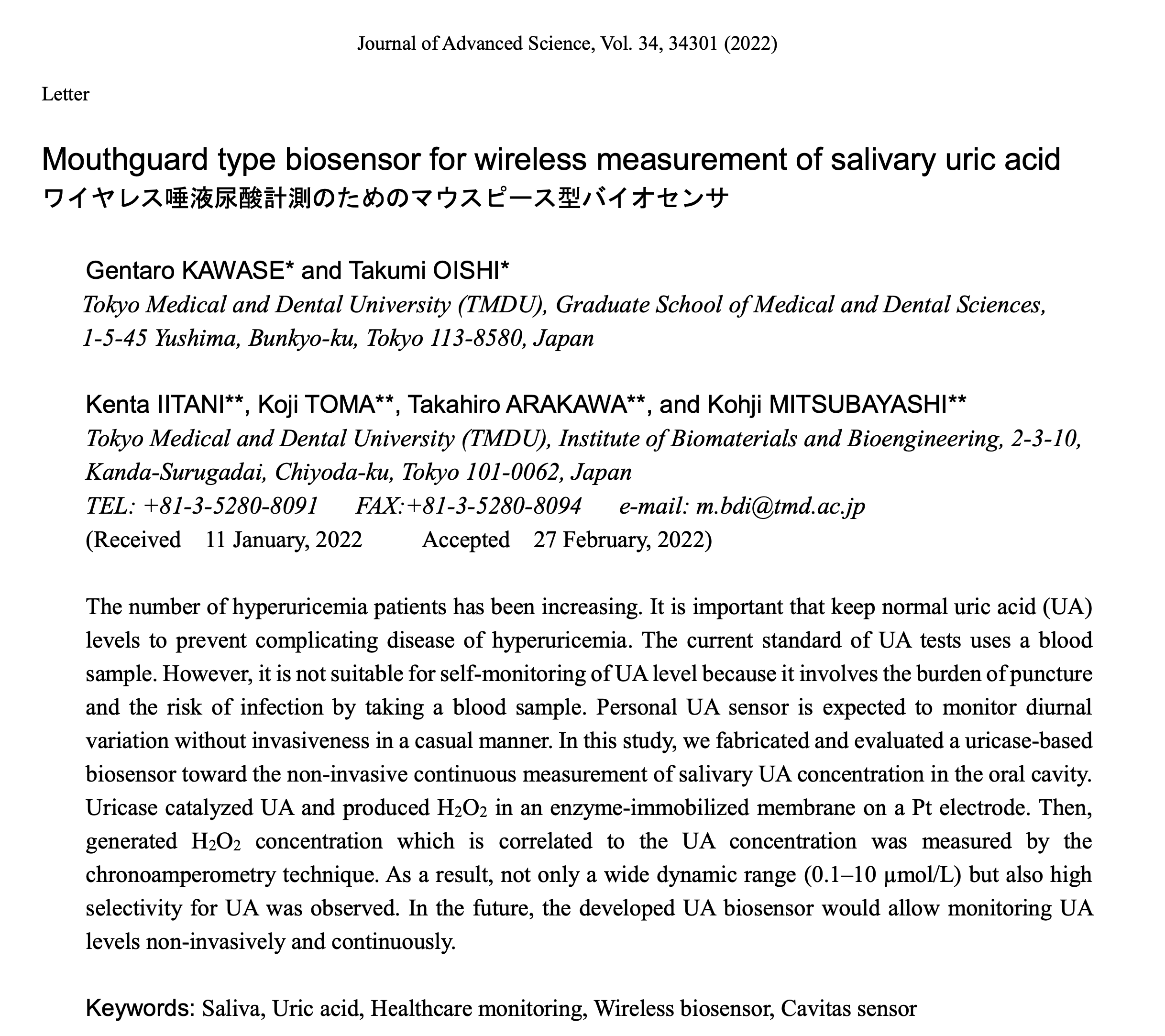
Gentaro Kawase, Takumi Oishi, Kenta Iitani, Koji Toma, Takahiro Arakawa, Kohji Mitsubayashi
Mouthguard type biosensor for wireless measurement of salivary uric acid
In: Journal of Advanced Science, vol. 34, pp. 34301, 2022, (Letter).
@article{Kawase2022,
title = {Mouthguard type biosensor for wireless measurement of salivary uric acid},
author = {Gentaro Kawase, Takumi Oishi, Kenta Iitani, Koji Toma, Takahiro Arakawa, Kohji Mitsubayashi},
url = {https://doi.org/10.2978/jsas.34301
https://iitani.com/wp-content/uploads/2022/06/34_34301.pdf},
doi = {10.2978/jsas.34301},
year = {2022},
date = {2022-06-01},
urldate = {2022-06-01},
journal = {Journal of Advanced Science},
volume = {34},
pages = {34301},
abstract = {The number of hyperuricemia patients has been increasing. It is important that keep normal uric acid (UA) levels to prevent complicating disease of hyperuricemia. The current standard of UA tests uses a blood sample. However, it is not suitable for self-monitoring of UA level because it involves the burden of puncture and the risk of infection by taking a blood sample. Personal UA sensor is expected to monitor diurnal variation without invasiveness in a casual manner. In this study, we fabricated and evaluated a uricase-based biosensor toward the non-invasive continuous measurement of salivary UA concentration in the oral cavity. Uricase catalyzed UA and produced H2O2 in an enzyme-immobilized membrane on a Pt electrode. Then, generated H2O2 concentration which is correlated to the UA concentration was measured by the chronoamperometry technique. As a result, not only a wide dynamic range (0.1–10 μmol/L) but also high selectivity for UA was observed. In the future, the developed UA biosensor would allow monitoring UA levels non-invasively and continuously.
},
note = {Letter},
keywords = {},
pubstate = {published},
tppubtype = {article}
}
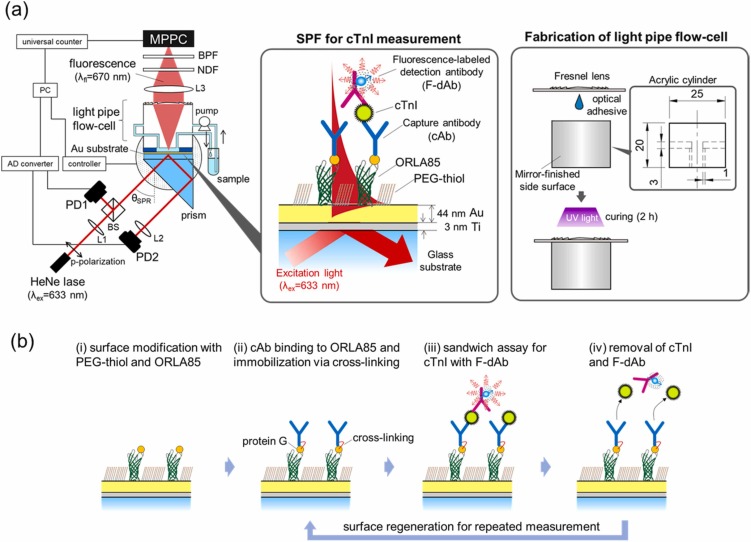
Koji Toma, Koki Oishi, Kenta Iitani, Takahiro Arakawa, Kohji Mitsubayashi
Surface plasmon-enhanced fluorescence immunosensor for monitoring cardiac troponin I
In: Sensors and Actuators B: Chemical, vol. 368, pp. 132132, 2022.
@article{Toma2022,
title = {Surface plasmon-enhanced fluorescence immunosensor for monitoring cardiac troponin I},
author = {Koji Toma, Koki Oishi, Kenta Iitani, Takahiro Arakawa, Kohji Mitsubayashi},
url = {https://www.sciencedirect.com/science/article/pii/S0925400522007742?via%3Dihub},
doi = {10.1016/j.snb.2022.132132},
year = {2022},
date = {2022-05-31},
urldate = {2022-05-31},
journal = {Sensors and Actuators B: Chemical},
volume = {368},
pages = {132132},
keywords = {},
pubstate = {published},
tppubtype = {article}
}
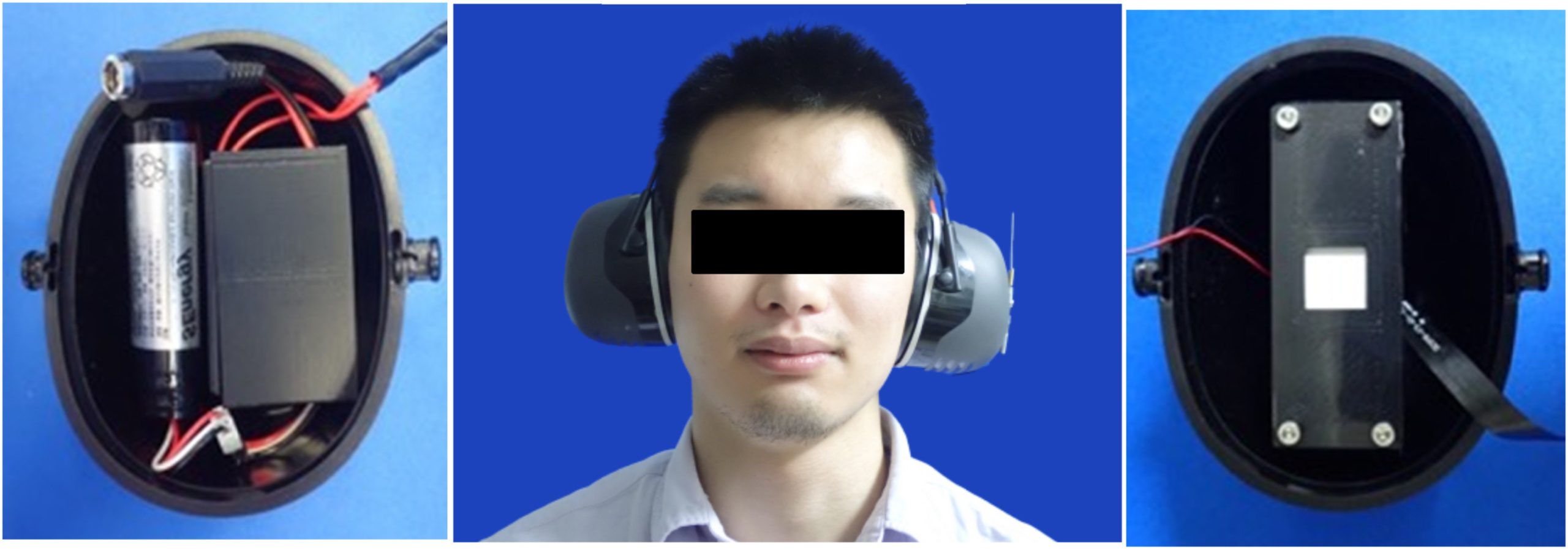
Takahiro Arakawa, Riki Ishikawa, Kenta Iitani, Koji Toma, Yasuhiko Iwasaki, Kohji Mitsubayashi
Headset bio-sniffer with wireless CMOS camera for percutaneous ethanol vapor from the ear canal
In: Biosensors and Bioelectronics: X, vol. 11, pp. 100169, 2022.
@article{Arakawa2022b,
title = {Headset bio-sniffer with wireless CMOS camera for percutaneous ethanol vapor from the ear canal},
author = {Takahiro Arakawa, Riki Ishikawa, Kenta Iitani, Koji Toma, Yasuhiko Iwasaki, Kohji Mitsubayashi},
url = {https://doi.org/10.1016/j.biosx.2022.100169},
doi = {10.1016/j.biosx.2022.100169},
year = {2022},
date = {2022-05-25},
urldate = {2022-05-25},
journal = {Biosensors and Bioelectronics: X},
volume = {11},
pages = {100169},
abstract = {Volatile organic compounds contained in human volatiles are related to metabolism and disease. Measurement of these components is expected to enable non-invasive and simple metabolic evaluations and disease diagnoses. In particular, skin gas can be collected continuously without constraints, a useful property for the next generation of wearable measurement devices. In this study, we develop a wearable biochemical gas sensor (biosniffer) for ethanol by constructing a headset-type unrestrained ear canal gas measurement system integrated with a complementary metal-oxide semiconductor (CMOS) camera. This system measures ethanol gas released by the skin by detecting the increase in fluorescence of NADH, which is produced during the oxidation of ethanol by alcohol dehydrogenase (ADH). In this system, excitation light from a UV-LED irradiates an ADH enzyme-immobilized membrane through a band-pass filter, and the fluorescence of NADH is detected by a small CMOS camera with Wi-Fi functionality. This system is integrated into an earmuff, forming a wearable headset. Fluorescence images shows an increased output correlated with the ethanol gas concentration. When integral analysis is used to assess the increase in fluorescence, it is possible to measure ethanol gas at 11 ppb–444 ppm, a range that includes the ethanol concentration in the skin after alcohol administration. Furthermore, when this device is attached to a human participant who is consuming alcohol, the increase and decrease output based on drinking and metabolism is confirmed, indicating the possibility of directly measuring ethanol gas from the ear canal with minimal effect of perspiration.},
keywords = {},
pubstate = {published},
tppubtype = {article}
}
2021

Kenta Iitani, Joel Tyson, Samyukta Rao, Sai Sathish Ramamurthy, Xudong Ge, Govind Rao
What Do Masks Mask? A Study on Transdermal CO2 Monitoring
In: Medical Engineering & Physics, vol. 98, pp. 50-56, 2021.
@article{Iitani2021c,
title = {What Do Masks Mask? A Study on Transdermal CO2 Monitoring},
author = {Kenta Iitani, Joel Tyson, Samyukta Rao, Sai Sathish Ramamurthy, Xudong Ge, Govind Rao},
url = {https://doi.org/10.1016/j.medengphy.2021.10.013},
doi = {10.1016/j.medengphy.2021.10.013},
year = {2021},
date = {2021-12-01},
journal = {Medical Engineering & Physics},
volume = {98},
pages = {50-56},
abstract = {Medical professionals have complained of extreme discomfort and fatigue from continuous wearing of N95 respirators (N95) overlaid with surgical masks (SM) and face shields (FS) during COVID-19 pandemic. However, there are no reports on the effect of face coverings on transdermal CO2 (TrCO2) levels (a measure of blood CO2) during moderate activity. In this study, real-time monitoring of TrCO2, heart rate and skin surface temperature was conducted for six subjects aged 20–59 years with and without wearing personal protective equipment (PPE). We initially studied the effect of wearing PPE (N95+SM+FS) at rest. Then, the effect of moderate stepping/walking activity (120 steps per minute for 60 min) while wearing PPE was evaluated. In addition, we investigated the effect of exercising intensity with different masks. We observed a significant difference (p<0.0001) in TrCO2 levels between without and with PPE during moderate exercise, but not while resting. TrCO2 levels were correlated to exercise intensity independently with masking condition and breathability of masks. For the first time, we present data showing that a properly fitting N95 worn along with SM and FS consistently leads to elevated TrCO2 under moderate exertion, which could contribute to fatigue over long-term use.},
keywords = {},
pubstate = {published},
tppubtype = {article}
}
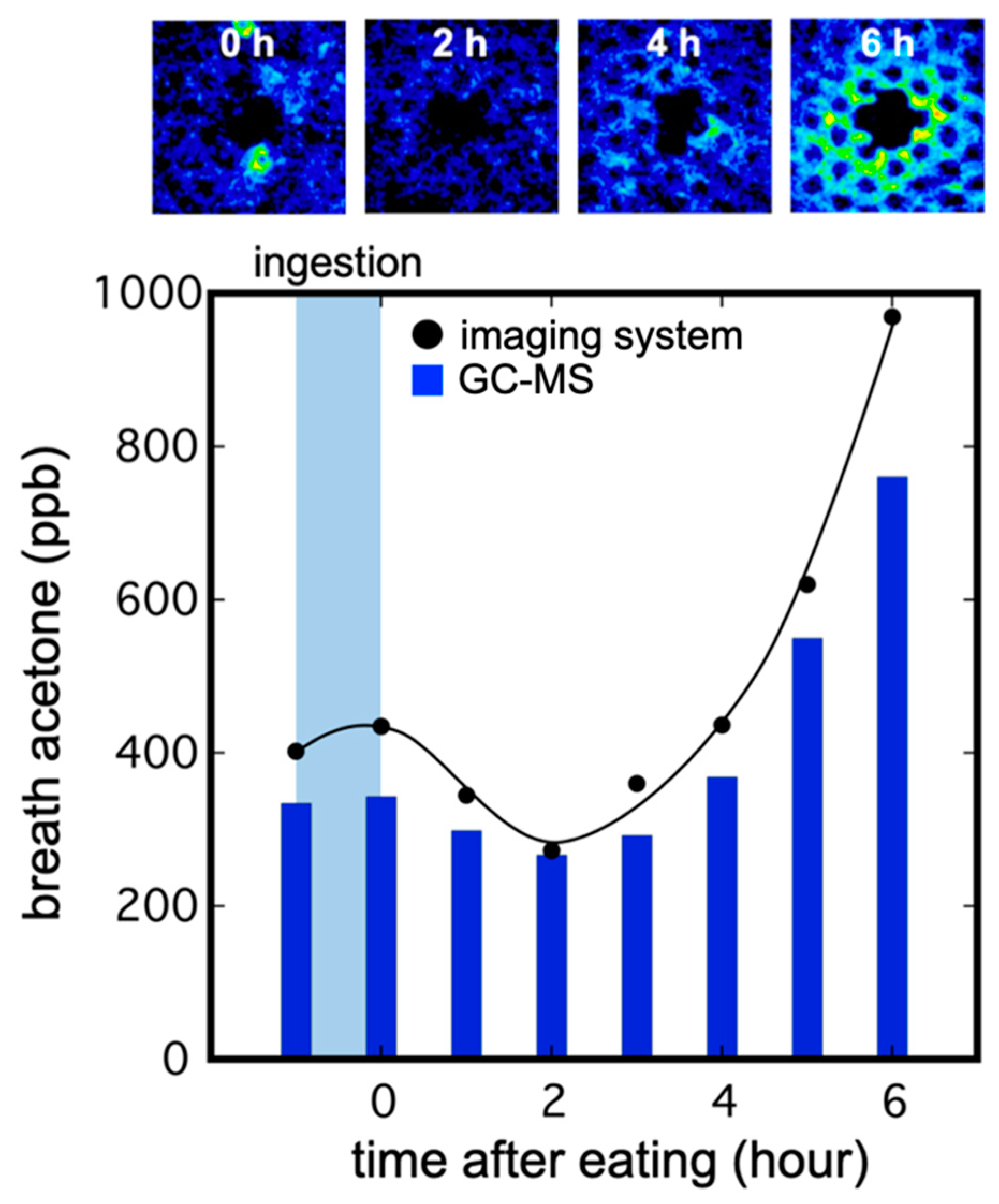
Takahiro Arakawa, Naoki Mizukoshi, Kenta Iitani, Koji Toma, Kohji Mitsubayashi
In: Chemosensors, vol. 9, no. 9, pp. 258, 2021.
@article{Arakawa2021,
title = {A Bio-Fluorometric Acetone Gas Imaging System for the Dynamic Analysis of Lipid Metabolism in Human Breath},
author = {Takahiro Arakawa, Naoki Mizukoshi, Kenta Iitani, Koji Toma, Kohji Mitsubayashi},
url = {https://doi.org/10.3390/chemosensors9090258 },
doi = {10.3390/chemosensors9090258},
year = {2021},
date = {2021-09-09},
journal = {Chemosensors},
volume = {9},
number = {9},
pages = {258},
abstract = {We constructed an imaging system to measure the concentration of acetone gas by acetone reduction using secondary alcohol dehydrogenase (S-ADH). Reduced nicotinamide adenine dinucleotide (NADH) was used as an electron donor, and acetone was imaged by fluorescence detection of the decrease in the autofluorescence of NADH. In this system, S-ADH–immobilized membranes wetted with buffer solution containing NADH were placed in a dark box, and UV-LED excitation sheets and a high-sensitivity camera were installed on both sides of the optical axis to enable loading of acetone gas. A hydrophilic polytetrafluoroethylene (H-PTFE) membrane with low autofluorescence was used as a substrate, and honeycomb-like through-hole structures were fabricated using a CO2 laser device. After loading the enzyme membrane with acetone gas standards, a decrease in fluorescence intensity was observed in accordance with the concentration of acetone gas. The degree of decrease in fluorescence intensity was calculated using image analysis software; it was possible to quantify acetone gas at concentrations of 50–2000 ppb, a range that includes the exhaled breath concentration of acetone in healthy subjects. We applied this imaging system to measure the acetone gas in the air exhaled by a healthy individual during fasting.},
keywords = {},
pubstate = {published},
tppubtype = {article}
}
Kenta Iitani, Sai Sathish Ramamurthy, Xudong Ge, Govind Rao
Transdermal sensing: in-situ non-invasive techniques for monitoring of human biochemical status
In: Curent Opinion in Biotechnology, vol. 71, pp. 198-205, 2021.
@article{Iitani2021,
title = {Transdermal sensing: in-situ non-invasive techniques for monitoring of human biochemical status},
author = {Kenta Iitani, Sai Sathish Ramamurthy, Xudong Ge, Govind Rao},
url = {https://doi.org/10.1016/j.copbio.2021.08.005},
doi = {10.1016/j.copbio.2021.08.005},
year = {2021},
date = {2021-08-26},
journal = {Curent Opinion in Biotechnology},
volume = {71},
pages = {198-205},
abstract = {Improving life expectancy necessitates prevention and early diagnosis of any disease state based on active self-monitoring of symptoms and longitudinal biochemical profiling. Non-invasive and continuous measurement of molecular biomarkers that reflect metabolism and health must however be established to realize this plan. Human samples non-invasively obtained via the skin are suitable in this context for in-situ biochemical monitoring. We present a brief classification of transdermal sampling in aqueous and gaseous phases and then introduce a new generation of transdermal monitoring devices for rapid and accurate assessment of important parameters. Finally, we have summarized the diversity of body-wide skin characteristics that have possible effects for transdermal sampling. Because of its passive nature, in-situ biochemical monitoring via transdermal sampling will potentially lead to a greater understanding of important biochemical markers and their temporal variation.},
keywords = {},
pubstate = {published},
tppubtype = {article}
}
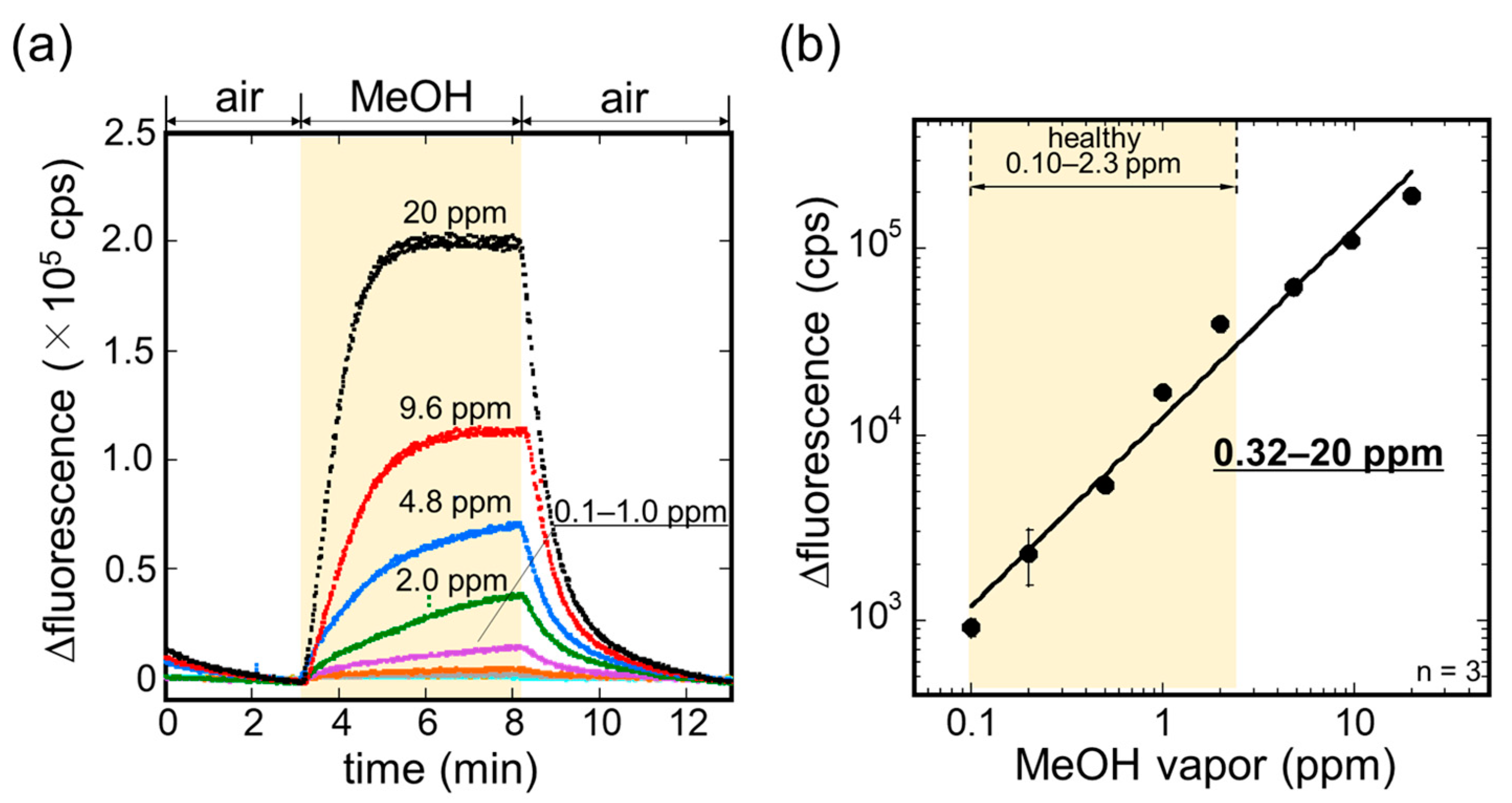
Koji Toma, Kanako Iwasaki, Geng Zhang, Kenta Iitani, Takahiro Arakawa, Yasuhiko Iwasaki, Kohji Mitsubayashi
In: Sensors (Basel), vol. 21, no. 14, pp. 4897, 2021.
@article{Toma2021,
title = {Biochemical Methanol Gas Sensor (MeOH Bio-Sniffer) for Non-Invasive Assessment of Intestinal Flora from Breath Methanol},
author = {Koji Toma, Kanako Iwasaki, Geng Zhang, Kenta Iitani, Takahiro Arakawa, Yasuhiko Iwasaki, Kohji Mitsubayashi},
url = {https://doi.org/10.3390/s21144897
https://iitani.com/wp-content/uploads/2022/05/2021-ktoma-Sensors.pdf},
doi = {10.3390/s21144897},
year = {2021},
date = {2021-07-19},
urldate = {2021-07-19},
journal = {Sensors (Basel)},
volume = {21},
number = {14},
pages = {4897},
abstract = {Methanol (MeOH) in exhaled breath has potential for non-invasive assessment of intestinal flora. In this study, we have developed a biochemical gas sensor (bio-sniffer) for MeOH in the gas phase using fluorometry and a cascade reaction with two enzymes, alcohol oxidase (AOD) and formaldehyde dehydrogenase (FALDH). In the cascade reaction, oxidation of MeOH was initially catalyzed by AOD to produce formaldehyde, and then this formaldehyde was successively oxidized via FALDH catalysis together with reduction of oxidized form of β-nicotinamide adenine dinucleotide (NAD+). As a result of the cascade reaction, reduced form of NAD (NADH) was produced, and MeOH vapor was measured by detecting autofluorescence of NADH. In the development of the MeOH bio-sniffer, three conditions were optimized: selecting a suitable FALDH for better discrimination of MeOH from ethanol in the cascade reaction; buffer pH that maximizes the cascade reaction; and materials and methods to prevent leaking of NAD+ solution from an AOD-FALDH membrane. The dynamic range of the constructed MeOH bio-sniffer was 0.32-20 ppm, which encompassed the MeOH concentration in exhaled breath of healthy people. The measurement of exhaled breath of a healthy subject showed a similar sensorgram to the standard MeOH vapor. These results suggest that the MeOH bio-sniffer exploiting the cascade reaction will become a powerful tool for the non-invasive intestinal flora testing.},
keywords = {},
pubstate = {published},
tppubtype = {article}
}
2020
Takahiro Arakawa, Takashi Aota, Kenta Iitani, Koji Toma, Yasuhiko Iwasaki, Kohji Mitsubayashi
In: Talanta, vol. 219, pp. 121187, 2020.
@article{Arakawa2020b,
title = {Skin ethanol gas measurement system with a biochemical gas sensor and gas concentrator toward monitoring of blood volatile compounds},
author = {Takahiro Arakawa and Takashi Aota and Kenta Iitani and Koji Toma and Yasuhiko Iwasaki and Kohji Mitsubayashi},
url = {https://www.sciencedirect.com/science/article/abs/pii/S0039914020304781?via%3Dihub},
doi = {10.1016/j.talanta.2020.121187},
year = {2020},
date = {2020-11-01},
journal = {Talanta},
volume = {219},
pages = {121187},
abstract = {We developed a biochemical gas sensor (bio-sniffer) using the enzymatic reaction of alcohol dehydrogenase (ADH) to target ethanol in skin gas. By introducing a gas concentrator using liquid nitrogen, we constructed a highly sensitive system for skin gas measurements. The ethanol bio-sniffer was built from an optical-fiber probe employing an ADH enzyme membrane, an UV-LED light source for excitation, and a photomultiplier tube. Ethanol was measured by detecting the autofluorescence of the coenzyme NADH due to the enzymatic reaction of ADH. We established a system for measuring concentrated gases by connecting the sensor with a gas concentrator and introducing concentrated skin gas to the sensing surface. This suppressed diffusion of the concentrated gases to achieve maximum fluorescence intensity by optimizing the measurement system. The calibration curve from obtained peak values showed ethanol gas can be measured over 1–3100 ppb, which included skin gas concentrations during alcohol consumption. Finally, when applied to measurements of ethanol in skin gas following alcohol consumption, the output was found to be dependent on concentration, similarly to using standard gases. Consecutive measurements were possible using periodic sampling with 6-min intervals for 180 min of monitoring. Skin ethanol concentrations rose from 20 min after consuming the alcohol, exhibited a peak value of 25 ppb skin gas ethanol at around 60 min, and gradually declined. Thus, the system can be used for non-invasive percutaneous evaluation of human volatile organic chemicals in blood.},
keywords = {},
pubstate = {published},
tppubtype = {article}
}
Takahiro Arakawa, Kenta Iitani, Koji Toma, Kohji Mitsubayashi
Biochemical Gas Sensor and Gas Imaging System for Non-invasive Screening: A Review
In: IEEJ Transactions on Sensors and Micromachines, vol. 140, no. 11, pp. 321–327, 2020.
@article{Arakawa2020bb,
title = {Biochemical Gas Sensor and Gas Imaging System for Non-invasive Screening: A Review},
author = {Takahiro Arakawa, Kenta Iitani, Koji Toma, Kohji Mitsubayashi},
url = {https://doi.org/10.1541/ieejsmas.140.321},
doi = {10.1541/ieejsmas.140.321},
year = {2020},
date = {2020-11-01},
urldate = {2020-11-01},
journal = {IEEJ Transactions on Sensors and Micromachines},
volume = {140},
number = {11},
pages = {321–327},
abstract = {The human body emits various volatile molecules, depending on a person's genetics, stress, disease and so on. The volatile organic compounds (VOCs) can be found in human transpiration, breath and transdermal gas emanated from skin. In this review, a biochemical gas sensor “bio-sniffer” and a gas imaging system “sniff-cam” for monitoring of VOCs such as acetone, ethanol and acetaldehyde were presented. Firstly, a high-sensitive acetone biochemical gas sensor was demonstrated and measure exhaled breath acetone concentration, and assess lipid metabolism based on breath acetone analysis. Secondly, a fluorometric imaging system for ethanol vapor released from human breath and palm skin was presented. This imaging system measures ethanol vapor concentrations as intensities of fluorescence through an enzymatic reaction. These biochemical gas sensors and imaging system of VOCs showed a rapidly and accurately responses and measurement, which could lead an analysis to metabolism function and non-invasive screening at real time in the near future.},
keywords = {},
pubstate = {published},
tppubtype = {article}
}
Kenta Iitani, Munire Naisierding, Koji Toma, Takahiro Arakawa, Kohji Mitsubayashi
In: Analyst, vol. 145, no. 8, pp. 2915–2924, 2020, (This paper is selected for the cover.).
@article{Iitani2020,
title = {Evaluation for regional difference of skin-gas ethanol and sweat rate using alcohol dehydrogenase-mediated fluorometric gas-imaging system (sniff-cam)},
author = {Kenta Iitani and Munire Naisierding and Koji Toma and Takahiro Arakawa and Kohji Mitsubayashi},
url = {https://pubs.rsc.org/en/content/articlelanding/2020/AN/C9AN02089F#!divAbstract},
doi = {doi.org/10.1039/C9AN02089F},
year = {2020},
date = {2020-03-05},
journal = {Analyst},
volume = {145},
number = {8},
pages = {2915–2924},
abstract = {Skin gas that contains volatile metabolites (volatilome) is emanated continuously and is thus expected to be suitable for non-invasive monitoring. The aim of this study was to investigate the relationship between the regional difference of sweat rate and skin volatilome distribution to identify the suitable site to monitor metabolisms. In this study, we developed a biofluorometric gas-imaging system (sniff-cam) based on nicotinamide adenine dinucleotide (NAD)-dependent alcohol dehydrogenase (ADH) to visualize transcutaneous ethanol (EtOH) distribution. The EtOH distribution was converted to a fluorescence distribution of reduced NAD with autofluorescence property. First, we optimized the solution volume and concentration of the oxidized NAD, which was a coenzyme of ADH. Owing to the optimization, a two-dimensional distribution of EtOH could be visualized from 0.05–10 ppm with good sensitivity and selectivity. Subsequently, transcutaneous EtOH imaging and measurement of sweat rate were performed at the palm, dorsum of hand, and wrist of participants who consumed alcohol. Transcutaneous EtOH from all skin parts was imaged using the sniff-cam; the concentrations initially increased until 30 min after drinking, followed by a gradual decrease. Although the determined peak EtOH concentrations of typical subjects were approximately 1100 ± 35 ppb (palm), which were higher than 720 ± 18 ppb (dorsum) and 620 ± 13 ppb (wrist), the results of sweat rate suggested that the dorsum of hand and the wrist were appropriate sites. Finally, the sniff-cam could visualize the individual difference of alcohol metabolism capacity originating from aldehyde dehydrogenase phenotype by imaging transcutaneous EtOH.},
note = {This paper is selected for the cover.},
keywords = {},
pubstate = {published},
tppubtype = {article}
}
Kenta Iitani, Koji Toma, Takahiro Arakawa, Kohji Mitsubayashi
In: ACS Sensors, vol. 5, no. 2, pp. 338–345, 2020, (This paper was selected for ACS sensors 2020-2022 showcase of wearable sensors. This paper was selected for the journal cover. Picked up in News outlets.).
@article{Iitani2019,
title = {Transcutaneous Blood VOC Imaging System (Skin-Gas Cam) with Real-Time Bio-Fluorometric Device on Rounded Skin Surface},
author = {Kenta Iitani and Koji Toma and Takahiro Arakawa and Kohji Mitsubayashi},
url = {https://pubs.acs.org/doi/10.1021/acssensors.9b01658},
doi = {10.1021/acssensors.9b01658},
year = {2020},
date = {2020-02-28},
urldate = {2020-02-28},
journal = {ACS Sensors},
volume = {5},
number = {2},
pages = {338–345},
abstract = {Skin gas that contains volatile metabolites (volatilome) is emanated continuously and is thus expected to be suitable for non-invasive monitoring. The aim of this study was to investigate the relationship between the regional difference of sweat rate and skin volatilome distribution to identify the suitable site to monitor metabolisms. In this study, we developed a biofluorometric gas-imaging system (sniff-cam) based on nicotinamide adenine dinucleotide (NAD)-dependent alcohol dehydrogenase (ADH) to visualize transcutaneous ethanol (EtOH) distribution. The EtOH distribution was converted to a fluorescence distribution of reduced NAD with autofluorescence property. First, we optimized the solution volume and concentration of the oxidized NAD, which was a coenzyme of ADH. Owing to the optimization, a two-dimensional distribution of EtOH could be visualized from 0.05–10 ppm with good sensitivity and selectivity. Subsequently, transcutaneous EtOH imaging and measurement of sweat rate were performed at the palm, dorsum of hand, and wrist of participants who consumed alcohol. Transcutaneous EtOH from all skin parts was imaged using the sniff-cam; the concentrations initially increased until 30 min after drinking, followed by a gradual decrease. Although the determined peak EtOH concentrations of typical subjects were approximately 1100 ± 35 ppb (palm), which were higher than 720 ± 18 ppb (dorsum) and 620 ± 13 ppb (wrist), the results of sweat rate suggested that the dorsum of hand and the wrist were appropriate sites. Finally, the sniff-cam could visualize the individual difference of alcohol metabolism capacity originating from aldehyde dehydrogenase phenotype by imaging transcutaneous EtOH.},
note = {This paper was selected for ACS sensors 2020-2022 showcase of wearable sensors. This paper was selected for the journal cover. Picked up in News outlets.},
keywords = {},
pubstate = {published},
tppubtype = {article}
}
2019
Kenta Iitani, Koji Toma, Takahiro Arakawa, Kohji Mitsubayashi
In: Analytical Chemistry, vol. 91, no. 15, pp. 9458–9465, 2019, (This paper introduced in the ACS PressPac.).
@article{Iitani2019c,
title = {Ultrasensitive Sniff-Cam for Biofluorometric-Imaging of Breath Ethanol Caused by Metabolism of Intestinal Flora},
author = {Kenta Iitani and Koji Toma and Takahiro Arakawa and Kohji Mitsubayashi},
url = {https://pubs.acs.org/doi/10.1021/acs.analchem.8b05840},
doi = {10.1021/acs.analchem.8b05840},
year = {2019},
date = {2019-08-06},
journal = {Analytical Chemistry},
volume = {91},
number = {15},
pages = {9458–9465},
abstract = {We developed a gas-imaging system (sniff-cam) for gaseous ethanol (EtOH) with improved sensitivity. The sniff-cam was applied to measure the extremely low concentration distribution of breath EtOH without the consumption of alcohol, which is related to the activity of the oral or gut bacterial flora. A ring-type ultraviolet-light-emitting diode was mounted around a camera lens as an excitation light source, which enabled simultaneous excitation and imaging of the fluorescence. In the EtOH sniff-cam, a nicotinamide adenine dinucleotide (NAD)-dependent alcohol dehydrogenase (ADH) was used to catalyze the redox reaction between EtOH and the oxidized form of NAD (NAD+). Upon application of gaseous EtOH to the ADH-immobilized mesh that was soaked in an NAD+ solution and placed in front of the camera, NADH was produced through an ADH-mediated reaction. NADH expresses fluorescence at an emission wavelength of 490 nm and excitation wavelength of 340 nm. Thus, the concentration distribution of EtOH was visualized by measuring the distribution of the fluorescence light intensity from NADH on the ADH-immobilized mesh surface. First, a comparison of image analysis methods based on the red–green–blue color (RGB) images and the optimization of the buffer pH and NAD+ solution concentration was performed. The new sniff-cam showed a 25-fold greater sensitivity and broader dynamic range (20.6–300000 ppb) in comparison to those of the previously fabricated sniff-cam. Finally, we measured the concentration distribution of breath EtOH without alcohol consumption using the improved sniff-cam and obtained a value of 116.2 ± 35.7 ppb (n = 10).
},
note = {This paper introduced in the ACS PressPac.},
keywords = {},
pubstate = {published},
tppubtype = {article}
}
Kenta Iitani, Yuuki Hayakawa, Koji Toma, Takahiro Arakawa, Kohji Mitsubayashi
In: Talanta, vol. 197, pp. 249–256, 2019.
@article{Iitani2019b,
title = {Switchable sniff-cam (gas-imaging system) based on redox reactions of alcohol dehydrogenase for ethanol and acetaldehyde in exhaled breath},
author = {Kenta Iitani and Yuuki Hayakawa and Koji Toma and Takahiro Arakawa and Kohji Mitsubayashi},
url = {https://www.sciencedirect.com/science/article/abs/pii/S0039914018313377?via%3Dihub},
doi = {10.1016/j.talanta.2018.12.070},
year = {2019},
date = {2019-05-15},
journal = {Talanta},
volume = {197},
pages = {249–256},
abstract = {Measuring the volatile organic compounds (VOCs) released from a human is a promising method for noninvasive disease screening and metabolism assessment. Selectively imaging multiple VOCs derived from human breath and skin gas is expected to improve current gas analysis techniques. In this study, a gas-imaging system (sniff-cam) that can be used to simultaneously image the concentration distribution of multiple VOCs, namely, ethanol (EtOH) and acetaldehyde (AcH), was developed. The sniff-cam was based on the pH-dependent redox reactions of nicotinamide adenine dinucleotide (NAD)-dependent alcohol dehydrogenase (ADH). The sniff-cam was constructed with a camera, two ADH-immobilized meshes, and a UV-LED array sheet. The ADH-immobilized mesh containing a solution of the oxidized form of NAD (NAD+) or reduced form (NADH) was used as an EtOH-imaging mesh and an AcH-imaging mesh, respectively. The distributions of the EtOH and AcH concentrations were visualized through the fluorescence of NADH (the excitation wavelength was 340 nm; the emission wavelength was 490 nm) occurring by the ADH-mediated redox reaction. First, the influence of pH on the activity of the redox reaction of ADH was measured, and then the quantitativeness and selectivity of the sniff-cam were evaluated. The ADH-mediated reactions of EtOH and AcH showed maximum activities at pH 9.0 and pH 6.5, respectively. The sniff-cam demonstrated not only a dynamic range (0.1–1000 ppm for EtOH and 0.2–10 ppm for AcH) for measuring EtOH and AcH in breath after drinking alcohol, but also displayed a high selectivity against other breath VOCs. Finally, EtOH and AcH in breath after drinking alcohol were measured simultaneously. A group with high activity of aldehyde dehydrogenase type 2 (EtOH = 143.3 ± 13.5 ppm, AcH = 1.7 ± 0.2 ppm) and a group with low activity (EtOH = 163.3 ± 28.0 ppm, AcH = 8.4 ± 0.5 ppm) displayed differences in the concentrations of EtOH and AcH contained in their breath samples, and the effectiveness of the developed method was confirmed and compared with previous results. It is suggested that the multiplexed sniff-cam in the future may be capable of selectively and simultaneously imaging various VOCs in human breath and skin gas by using multiple NADH-dependent enzymes.
},
keywords = {},
pubstate = {published},
tppubtype = {article}
}
Takahiro Arakawa, Takuma Suzuki, Masato Suzuki, Kenta Iitani, Po-Jen Chien, Ming Ye, Koji Toma, Yasuhiko Iwasaki, Kohji Mitsubayashi
In: Biosensors and Bioelectronics, vol. 129, pp. 245–253, 2019.
@article{Arakawa2019,
title = {Real-time monitoring of skin ethanol gas by a high-sensitivity gas phase biosensor (bio-sniffer) for the non-invasive evaluation of volatile blood compounds},
author = {Takahiro Arakawa and Takuma Suzuki and Masato Suzuki and Kenta Iitani and Po-Jen Chien and Ming Ye and Koji Toma and Yasuhiko Iwasaki and Kohji Mitsubayashi},
url = {https://www.sciencedirect.com/science/article/pii/S0956566318307681?via%3Dihub},
doi = {10.1016/j.bios.2018.09.070},
year = {2019},
date = {2019-03-15},
urldate = {2019-03-15},
journal = {Biosensors and Bioelectronics},
volume = {129},
pages = {245–253},
abstract = {In this study, a highly sensitive and selective biochemical gas sensor (bio-sniffer) and real-time monitoring system with skin gas cell was constructed for the determination of ethanol gas concentration on human skin. This bio-sniffer measured the concentration of ethanol according to the change in fluorescence intensity of nicotinamide adenine dinucleotide (NADH), which is produced in an enzymatic reaction by alcohol dehydrogenase (ADH). The NADH detection system used an ultraviolet light emitting diode (UV–LED) as the excitation light, and a highly sensitive photomultiplier tube as a fluorescence intensity detector. The calibration range of the ethanol bio-sniffer was validated from 25 ppb to 128 ppm. To measure the concentration of ethanol within skin gas, subjects ingested an alcohol beverage, and the sensor output was monitored. We chose the central part of the palm, a back of the hand, and a wrist as targets. The real-time concentration of skin ethanol gas at each target was measured after drinking. The maximum output values were reached at approximately 70 min after drinking and then gradually decreased. We showed that ethanol release kinetics were different depending on the part of the hand measured with the developed monitoring system. Accordingly, this highly sensitive and selective bio-sniffer with a skin gas cell could be used to measure ethanol on the skin surface and could be applied for breath and skin gas research, as well as investigation of volatile blood compounds used as biomarkers for clinical diagnosis.
},
keywords = {},
pubstate = {published},
tppubtype = {article}
}
2018
Kenta Iitani, Po-Jen Chien, Takuma Suzuki, Koji Toma, Takahiro Arakawa, Yasuhiko Iwasaki, Kohji Mitsubayashi
In: ACS Sensors, vol. 3, no. 2, pp. 425–431, 2018.
@article{Iitani2018b,
title = {Fiber-Optic Bio-sniffer (Biochemical Gas Sensor) Using Reverse Reaction of Alcohol Dehydrogenase for Exhaled Acetaldehyde},
author = {Kenta Iitani and Po-Jen Chien and Takuma Suzuki and Koji Toma and Takahiro Arakawa and Yasuhiko Iwasaki and Kohji Mitsubayashi},
url = {http://pubs.acs.org/doi/10.1021/acssensors.7b00865},
doi = {10.1021/acssensors.7b00865},
year = {2018},
date = {2018-02-23},
journal = {ACS Sensors},
volume = {3},
number = {2},
pages = {425–431},
abstract = {Volatile organic compounds (VOCs) exhaled in breath have huge potential as indicators of diseases and metabolisms. Application of breath analysis for disease screening and metabolism assessment is expected since breath samples can be noninvasively collected and measured. In this research, a highly sensitive and selective biochemical gas sensor (bio-sniffer) for gaseous acetaldehyde (AcH) was developed. In the AcH bio-sniffer, a reverse reaction of alcohol dehydrogenase (ADH) was employed for reducing AcH to ethanol and simultaneously consuming a coenzyme, reduced form of nicotinamide adenine dinucleotide (NADH). The concentration of AcH can be quantified by fluorescence detection of NADH that was consumed by reverse reaction of ADH. The AcH bio-sniffer was composed of an ultraviolet light-emitting diode (UV-LED) as an excitation light source, a photomultiplier tube (PMT) as a fluorescence detector, and an optical fiber probe, and these three components were connected with a bifurcated optical fiber. A gas-sensing region of the fiber probe was developed with a flow-cell and an ADH-immobilized membrane. In the experiment, after optimization of the enzyme reaction conditions, the selectivity and dynamic range of the AcH bio-sniffer were investigated. The AcH bio-sniffer showed a short measurement time (within 2 min) and a broad dynamic range for determination of gaseous AcH, 0.02–10 ppm, which encompassed a typical AcH concentration in exhaled breath (1.2–6.0 ppm). Also, the AcH bio-sniffer exhibited a high selectivity to gaseous AcH based on the specificity of ADH. The sensor outputs were observed only from AcH-contained standard gaseous samples. Finally, the AcH bio-sniffer was applied to measure the concentration of AcH in exhaled breath from healthy subjects after ingestion of alcohol. As a result, a significant difference of AcH concentration between subjects with different aldehyde dehydrogenase type 2 (ALDH2) phenotypes was observed. The AcH bio-sniffer can be used for breath measurement, and further, an application of breath analysis-based disease screening or metabolism assessment can be expected due to the versatility of its detection principle, which allows it to measure other VOCs by using NADH-dependent dehydrogenases.
},
keywords = {},
pubstate = {published},
tppubtype = {article}
}
Kenta Iitani, Toshiyuki Sato, Munire Naisierding, Yuuki Hayakawa, Koji Toma, Takahiro Arakawa, Kohji Mitsubayashi
In: Analytical Chemistry, vol. 90, no. 4, pp. 2678–2685, 2018.
@article{Iitani2018,
title = {Fluorometric Sniff-Cam (Gas-Imaging System) Utilizing Alcohol Dehydrogenase for Imaging Concentration Distribution of Acetaldehyde in Breath and Transdermal Vapor after Drinking},
author = {Kenta Iitani and Toshiyuki Sato and Munire Naisierding and Yuuki Hayakawa and Koji Toma and Takahiro Arakawa and Kohji Mitsubayashi},
url = {https://pubs.acs.org/doi/10.1021/acs.analchem.7b04474},
doi = {10.1021/acs.analchem.7b04474},
year = {2018},
date = {2018-02-20},
journal = {Analytical Chemistry},
volume = {90},
number = {4},
pages = {2678–2685},
abstract = {Understanding concentration distributions, release sites, and release dynamics of volatile organic compounds (VOCs) from the human is expected to lead to methods for noninvasive disease screening and assessment of metabolisms. In this study, we developed a visualization system (sniff-cam) that enabled one to identify a spatiotemporal change of gaseous acetaldehyde (AcH) in real-time. AcH sniff-cam was composed of a camera, a UV-LED array sheet, and an alcohol dehydrogenase (ADH)-immobilized mesh. A reverse reaction of ADH was employed for detection of gaseous AcH where a relationship between fluorescence intensity from nicotinamide adenine dinucleotide and the concentration of AcH was inversely proportional; thus, the concentration distribution of AcH was measured by detecting the fluorescence decrease. Moreover, the image differentiation method that calculated a fluorescence change rate was employed to visualize a real-time change in the concentration distribution of AcH. The dynamic range of the sniff-cam was 0.1–10 ppm which encompassed breath AcH concentrations after drinking. Finally, the sniff-cam achieved the visualization of the concentration distribution of AcH in breath and skin gas. A clear difference of breath AcH concentration was observed between aldehyde dehydrogenase type 2 active and inactive subjects, which was attributed to metabolic capacities of AcH. AcH in skin gas showed a similar time course of AcH concentration to the breath and a variety of release concentration distribution. Using different NADH-dependent dehydrogenases in the sniff-cam could lead to a versatile method for noninvasive disease screening by acquiring spatiotemporal information on various VOCs in breath or skin gas.
},
keywords = {},
pubstate = {published},
tppubtype = {article}
}
2017
Kenta Iitani, Po-Jen Chien, Takuma Suzuki, Koji Toma, Takahiro Arakawa, Yasuhiko Iwasaki, Kohji Mitsubayashi
In: ACS Sensors, vol. 2, no. 7, pp. 940–946, 2017, (This paper introduced in the ACS PressPac.).
@article{Iitani2017,
title = {Improved Sensitivity of Acetaldehyde Biosensor by Detecting ADH Reverse Reaction-Mediated NADH Fluoro-Quenching for Wine Evaluation},
author = {Kenta Iitani and Po-Jen Chien and Takuma Suzuki and Koji Toma and Takahiro Arakawa and Yasuhiko Iwasaki and Kohji Mitsubayashi},
url = {https://pubs.acs.org/doi/abs/10.1021/acssensors.7b00184},
doi = {10.1021/acssensors.7b00184},
year = {2017},
date = {2017-07-28},
journal = {ACS Sensors},
volume = {2},
number = {7},
pages = {940–946},
note = {This paper introduced in the ACS PressPac.},
keywords = {},
pubstate = {published},
tppubtype = {article}
}
Kenta Iitani, Toshiyuki Sato, Munire Naisierding, Yuuki Hayakawa, Koji Toma, Takahiro Arakawa, Kohji Mitsubayashi
In: Analyst, vol. 142, no. 20, pp. 3830–3836, 2017.
@article{Iitani2017b,
title = {Fluorometric gas-imaging system (sniff-cam), using the extinction of NADH with an ADH reverse reaction, for acetaldehyde in the gas phase},
author = {Kenta Iitani and Toshiyuki Sato and Munire Naisierding and Yuuki Hayakawa and Koji Toma and Takahiro Arakawa and Kohji Mitsubayashi},
url = {https://pubs.rsc.org/en/content/articlelanding/2017/AN/C7AN00524E#!divAbstract},
doi = {10.1039/C7AN00524E},
year = {2017},
date = {2017-07-19},
journal = {Analyst},
volume = {142},
number = {20},
pages = {3830–3836},
abstract = {A gas-imaging system (sniff-cam) that allows fluorometric visualization of a two-dimensional (2-D) distribution of gaseous acetaldehyde (AcH) was developed. It employed a reverse reaction of a nicotinamide adenine dinucleotide (NADH) dependent enzyme that led to consumption of NADH in that reaction. The system was constructed with a highly sensitive camera, an ultraviolet light emitting diode array sheet, two band pass filters and an alcohol dehydrogenase (ADH)-immobilized mesh that was used for AcH detection. The reverse reaction of the ADH catalyzed the reduction of AcH to ethanol and the oxidation of NADH to NAD+, which occurred when gaseous AcH was applied to the ADH immobilized mesh that was wetted with a slightly acidic NADH solution. As NADH has an autofluorescence property [emission (λem) at 490 nm; excitation (λex) at 340 nm], the presence of gaseous AcH was visualized by a decrease of fluorescence of the NADH at the ADH immobilized mesh. After constructing the gaseous AcH imaging system, optimizations of pH, and concentration of the NADH solution were performed. As a result of the optimizations (500 μM of NADH in 0.1 M of Tris hydrochloride (Tris-HCl) buffer at pH 6.5), the AcH sniff-cam showed a wide dynamic range (0.1–10 ppm) for gaseous AcH with a high correlation coefficient (R = 0.999). Furthermore, a fluorescence gradient with a rounded shape centered in a gas outlet was observed. These results demonstrated that the AcH sniff-cam utilizing the fluorescence decrease of NADH could be used to quantitatively evaluate the 2-D distribution of gaseous AcH.
},
keywords = {},
pubstate = {published},
tppubtype = {article}
}
Takahiro Arakawa, Toshiyuki Sato, Kenta Iitani, Koji Toma, Kohji Mitsubayashi
In: Analytical Chemistry, vol. 89, no. 8, pp. 4495–4501, 2017.
@article{Arakawa2017,
title = {Fluorometric Biosniffer Camera “Sniff-Cam” for Direct Imaging of Gaseous Ethanol in Breath and Transdermal Vapor},
author = {Takahiro Arakawa and Toshiyuki Sato and Kenta Iitani and Koji Toma and Kohji Mitsubayashi},
url = {https://pubs.acs.org/doi/10.1021/acs.analchem.6b04676},
doi = {10.1021/acs.analchem.6b04676},
year = {2017},
date = {2017-04-18},
journal = {Analytical Chemistry},
volume = {89},
number = {8},
pages = {4495–4501},
abstract = {Various volatile organic compounds can be found in human transpiration, breath and body odor. In this paper, a novel two-dimensional fluorometric imaging system, known as a “sniffer-cam” for ethanol vapor released from human breath and palm skin was constructed and validated. This imaging system measures ethanol vapor concentrations as intensities of fluorescence through an enzymatic reaction induced by alcohol dehydrogenase (ADH). The imaging system consisted of multiple ultraviolet light emitting diode (UV-LED) excitation sheet, an ADH enzyme immobilized mesh substrate and a high-sensitive CCD camera. This imaging system uses ADH for recognition of ethanol vapor. It measures ethanol vapor by measuring fluorescence of nicotinamide adenine dinucleotide (NADH), which is produced by an enzymatic reaction on the mesh. This NADH fluorometric imaging system achieved the two-dimensional real-time imaging of ethanol vapor distribution (0.5–200 ppm). The system showed rapid and accurate responses and a visible measurement, which could lead to an analysis of metabolism function at real time in the near future.
},
keywords = {},
pubstate = {published},
tppubtype = {article}
}
2015
Takahiro Arakawa, Kenta Iitani, Xin Wang, Takumi Kajiro, Koji Toma, Kazuyoshi Yano, Kohji Mitsubayashi
A sniffer-camera for imaging of ethanol vaporization from wine: the effect of wine glass shape
In: Analyst, vol. 140, no. 8, pp. 2881–2886, 2015, (This paper introduced in Chemistry World, CNN, Scientific American, National Geographic, and etc.).
@article{Arakawa2015,
title = {A sniffer-camera for imaging of ethanol vaporization from wine: the effect of wine glass shape},
author = {Takahiro Arakawa and Kenta Iitani and Xin Wang and Takumi Kajiro and Koji Toma and Kazuyoshi Yano and Kohji Mitsubayashi},
url = {https://pubs.rsc.org/en/content/articlelanding/2015/AN/C4AN02390K#!divAbstract},
doi = {10.1039/C4AN02390K},
year = {2015},
date = {2015-02-23},
journal = {Analyst},
volume = {140},
number = {8},
pages = {2881–2886},
abstract = {A two-dimensional imaging system (Sniffer-camera) for visualizing the concentration distribution of ethanol vapor emitting from wine in a wine glass has been developed. This system provides image information of ethanol vapor concentration using chemiluminescence (CL) from an enzyme-immobilized mesh. This system measures ethanol vapor concentration as CL intensities from luminol reactions induced by alcohol oxidase and a horseradish peroxidase (HRP)–luminol–hydrogen peroxide system. Conversion of ethanol distribution and concentration to two-dimensional CL was conducted using an enzyme-immobilized mesh containing an alcohol oxidase, horseradish peroxidase, and luminol solution. The temporal changes in CL were detected using an electron multiplier (EM)-CCD camera and analyzed. We selected three types of glasses—a wine glass, a cocktail glass, and a straight glass—to determine the differences in ethanol emission caused by the shape effects of the glass. The emission measurements of ethanol vapor from wine in each glass were successfully visualized, with pixel intensity reflecting ethanol concentration. Of note, a characteristic ring shape attributed to high alcohol concentration appeared near the rim of the wine glass containing 13 °C wine. Thus, the alcohol concentration in the center of the wine glass was comparatively lower. The Sniffer-camera was demonstrated to be sufficiently useful for non-destructive ethanol measurement for the assessment of food characteristics.
},
note = {This paper introduced in Chemistry World, CNN, Scientific American, National Geographic, and etc.},
keywords = {},
pubstate = {published},
tppubtype = {article}
}
2014
Kenta Iitani, Toshiyuki Sato, Xin Wang, Koji Toma, Takahiro Arakawa, Kohji Mitsubayashi
“Sniffer-camera” using enzyme reaction for visualization of transpired ethanol from palm skin
In: Journal of Advanced Science, vol. 26, no. 3+4, pp. 20–22, 2014, (Letter).
@article{Iitani2014,
title = {“Sniffer-camera” using enzyme reaction for visualization of transpired ethanol from palm skin},
author = {Kenta Iitani and Toshiyuki Sato and Xin Wang and Koji Toma and Takahiro Arakawa and Kohji Mitsubayashi},
url = {https://www.jstage.jst.go.jp/article/jsas/26/3+4/26_150225699/_article/-char/en
https://iitani.com/wp-content/uploads/2022/05/26_150225699.pdf},
doi = {10.2978/jsas.26.20},
year = {2014},
date = {2014-05-20},
urldate = {2014-05-20},
journal = {Journal of Advanced Science},
volume = {26},
number = {3+4},
pages = {20–22},
abstract = {An imaging system for gaseous ethanol transpired from human palm skin, based on an enzymatic reaction, was assembled and validated. This system uses a highly sensitive camera that measures gaseous ethanol concentrations as intensities of chemiluminescence from luminol’s reaction induced by alcohol oxidase (AOD) and a luminol-hydrogen peroxide-horseradish peroxidase (HRP) system. Conversion of gaseous ethanol concentrations and distributions proceed on an enzyme-immobilized mesh substrate with luminol solution in a dark box. In order to visualize ethanol transpired from human palm skin, we improved the chemiluminescence sensitivity of the imaging system with a mixture of a high-purity luminol solution of luminol sodium salt HG solution and an enhancer of eosin Y solution. The detection limit of the ethanol concentration was 4.9 ppm. This highly sensitive imaging allows successful visualization of ethanol transpired from palm skin.
},
note = {Letter},
keywords = {},
pubstate = {published},
tppubtype = {article}
}
